#adding a third person to any story is going to change something its inevitable whether its a plot point a dynamic or an outcome
Explore tagged Tumblr posts
Text
I usually don't mind adding oc's into fics, in fact I read quite a few cause they can be interesting - and I write a few in my own time for my own entertainment, but I have yet to read one that does s8 and s9 of doctor who justice because there is a fundamental misunderstanding of 12 and clara in both of those seasons - and that, by adding a third person who can make the Doctor change his mind and not do some of the equally toxic things he did to Clara it just comes across as heavily one-sided toxic dynamic or they completely ignore both aspects and write the series unchanged with a third person there mildly disapproving
#honestly its the two of three series where its a detriment to add another person#unless youre going to add someone incredibly toxic in as well to add a third into their dynamic (which honestly is covered by missy anyway)#like i hate to break it to people but both 12 and clara were just as bad as each other and thats the point of their dynamic#adding a third person to any story is going to change something its inevitable whether its a plot point a dynamic or an outcome#i dont even think i could handle adding an oc to s8 or s9 because like what the fuck would they add in that scenario#the reason 12 and clara work is because theyre as bad as each other hence the hybrid and thats why i love them#ray talks
0 notes
Text
Dead Apple Light Novel
Recently, I decided to buy LN 5, Dead Apple, purely because I’m a sucker for all of BSD’s light novels, so this post will revolve around what I took away from this novel.
Dead Apple is Canon
Since the story jumps around in the timeline a lot, I had originally thought that Dead Apple took place outside of canon (especially with Atsushi’s flashback).
However, a particular part of Asagiri’s afterword stuck out to me:
Now, allow me a moment to discuss some of the particulars of Dead Apple. Chronologically, the story takes place after the second season of the anime — in other words, after the war with the Guild, which puts Dead Apple somewhere between the ninth and tenth volumes of the manga.
The novel also ended up affecting the main story in numerous ways, and I’m sure this new experience will continue to influence my future work as well.
It’s not unusual for a light novel to insert itself into the main timeline (see 55 Minutes which takes place in the 10th volume), but it’s nice to have confirmation that the same applies to Dead Apple.
Of course, just because a work isn’t canon compliant (see BEAST), doesn’t mean that it has no potential for further analysis or it doesn’t bring any added complexity to the main plot. Regardless, this post serves as somewhat of a precursor to my other posts concerning Dead Apple since I have a tendency to talk about it a lot, and I’d like to establish a basis for a lot of my posts.
Differences between the Movie and Light Novel
In the afterword of the light novel, Hiro Iwahata (the author of this LN) said:
“Furthermore, I worked on this book under Asagiri’s supervision, meaning there are several lines in certain scenes that differ from the movie. It might even be fun comparing the two! Nothing would make me happier than the fans enjoying this novel alongside the movie.”
As per Iwahata’s request, I went into the light novel, looking for differences between it and the movie. However, the novel is surprisingly, almost identical to the movie (maybe not surprising considering it is a “movie novelization”).
Because the differences are so miniscule, I believe they hold an even greater significance, since Asagiri must have wanted to change these specific details for a certain reason.
Some of the differences I talk about might be unimportant, but I did my best to catch everything that was changed from the movie.
1. The movie doesn’t mention SKK as a part of the Dragon’s Head Conflict, but the novel says, “Some fought under the alias Twin Dark.”
This probably means that SKK became a pair either before the Dragon’s Head Conflict or during (although I’m pretty sure that the “organization” they destroyed over night was Shibusawa’s organization).
2. When Dazai says that he would’ve continued killing people in the mafia if it weren’t for Oda, Atsushi has little to no reaction in the movie; I would describe it as maybe a hesitant or concerned feeling.

In the novel, Atsushi has a more outward reaction.
““Huh...?!” Atsushi was baffled. He had no idea whether that was true. What did Dazai mean by that? (...) The melancholy Atsushi felt from Dazai had disappeared, and Dazai continued to speak in his usual lighthearted manner.”
Not only does he react verbally, but the novel also adds an inner monologue (mainly for Atsushi) that can’t be portrayed as well in movie format.
To me, this change highlights how Atsushi sees Dazai purely as a good person; he reacts in such a startled manner because he believes that Dazai is too good of a person to be in the mafia killing people (which we know Atsushi hates). This trend reoccurs throughout the story, of Atsushi turning a blind eye to Dazai’s “bad side.”
3. This one isn’t at all the movie’s fault, but the novel gives a lot more clues as to what the “dead apple” and the dagger in the apple motif represents.
The first time it appears is when Kunikida and Tanizaki meet the Special Division’s agent, but they find out that he’s already dead.
“It [the apple] was, without a doubt, a simple fruit... save for the fact that there was a knife sticking out of it as if to condemn the taste of sin. A blade had been driven into the symbol of original sin. A dreary, ominous aura, oozed from the ripe fruit like venom.
Throughout the novel, it seems to associate the “dead apple” motif with Fyodor pretty strongly, especially since this paragraph ties in Fyodor’s ideals nicely with the symbolism of the apple and dagger.
The apple represents sin, the very first sin — which you could interpret as sin at its purest — while the dagger represents the condemning of such sin. However, the apple can also potentially symbolize life, while the dagger stabbing into life can mean death.
Fyodor’s ideals revolve around “removing the sin” of ability users (represented by an apple in this case) but he does so through manipulation. The dagger is associated with stealth and deception, which is fitting with what Fyodor does to “remove the sin” of ability users.
However, he’s also taking the lives of ability users in this process, hence stabbing the apple, coincidentally committing another sin in his attempt to relinquish all sin.
4. In the “Snow White” Oda and Dazai flashback, everything is identical to the movie (word for word), but there is some additional narration.
“It was an alarming sight — Dazai sounded like he was in a trance. It was as if he was ignoring all this world had to offer while in pursuit of something else.”
I’ve talked about this particular scene before here, but the gist is that Dazai was discreetly talking about himself while referring to Snow White.
Dazai joined the mafia because he believed that the violence (or true human nature) would give him a reason to live, but we already know that this kind of thinking was flawed. Thus, this line most likely means that Dazai was ignoring all of the “good” qualities of the world while pursuing a reason to live, which inevitably wouldn’t work.
5. Right after the flashback, when Dazai takes the pill, the novel really sells the act of “Dazai walking towards his death and going to the evil side.”
Personally, this scene in the movie felt more open to interpretation after you’ve seen the ending. You could say that Dazai took the antidote and said “Being on the side that saves people is more beautiful,” because his plan is to continue living to save more people.
However, the novel throws away any possible double meaning with this paragraph:
“Dazai then reached for the pill with his bandaged hand, neatly picked it up, and slowly brought it to his lips — just like Snow White and the sweet, poisoned apple. The venomous red-and-pure-white-pill disappeared inside his mouth.”
After Dazai’s tangent on how Snow White could’ve committed suicide out of despair, the narration compares him directly to Snow White. With the added venomous pill stated outright, it only further cements the idea that Dazai’s actually committing suicide here.
I don’t particularly like this change, because it feels like this moment was set up entirely just to divert the audience’s expectations, rather than it be a standalone scene that makes sense when considering the rest of the story. (It might not necessarily be a change, possibly just a rough translation from movie to novel).
6. When Atsushi wakes up from his nightmare, there’s some additional inner monologue:
Everything’s okay. I’m not the same person I was when I lived at the orphanage. I have friends. I have a place where I belong — the Armed Detective Agency. Things are different now.
The anime (and in turn the movie) tends to downplay the effects of Atsushi’s trauma — probably due to the limitations of anime — but regardless the novel portrays it much better with how Atsushi’s trauma affects practically every aspect of his life.
7. I thought Fukuzawa’s ability only gave his subordinates control over their abilities, but the novel says:
“Yukichi Fukuzawa and his skill, All Men are Equal, a peculiar ability that allowed him to suppress and control his subordinates’ skills.”
Does this mean that Fukuzawa could control and suppress all of the agency’s abilities? It could be a weird translation, but it seems oddly specific.
8. This detail isn’t actually a novel exclusive, but it is an extremely small detail that I missed while watching the movie, so I figured I would add it here too.
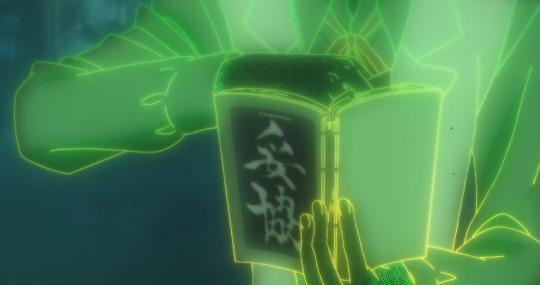
“the phantom’s notebook had the word Compromise written on the cover. A copy of himself that didn’t follow ideals but made compromises was an abomination to Kunikida.”
Considering how abilities act as the shadow to every character in this story, this is a nice detail that shows how Kunikida’s inner desire is to compromise, because carrying such heavy ideals is undoubtedly a burden. However, because he holds onto his ideals so strongly, it becomes his biggest weakness AND his biggest strength.
9. There’s a super small detail added to this scene with Dazai, Fyodor, and Shibusawa. When Dazai suggests that Shibusawa could be saved by an angel or a demon, the following exchange occurs:
“Hmm... Maybe an angel?” Dazai picked up the skull on the table. “Or maybe a demon?” “It’s obvious what both of your true intentions are, if you ask me.” The third man mirthfully cackled and took the skull from Dazai’s hand.
In the movie, Dazai doesn’t pick up anything, so as a result Fyodor doesn’t take anything from Dazai either.
Because Fyodor walked into the scene after Dazai suggested that an angel or demon would save Shibusawa, I strongly suspect that this was foreshadowing future events in which Fyodor does “save” Shibusawa by giving him his memories back.
The novel adds more to this foreshadowing by having Dazai pick up the skull before it’s taken by Fyodor — essentially having Fyodor take the cards out of Dazai’s hands and put them in his favor.
It’s also worth pointing out that the skull is also the object that Fyodor uses to revive Shibusawa into a supernatural ghost of some sorts at the end of the story.
10. This may be just a difference in translations but in the movie, Shibusawa refers to Fyodor as “Demon Fyodor-kun”, whereas in the novel Fyodor is called “Fyodor the Conjurer.” (Ango uses the Conjurer title as well).
In western esotericism, a conjurer is a person who summons supernatural beings, like spirits, demons, or God.
This slightly changes the connotation of Fyodor’s title from a inhuman being of pure malicious intent to just a human who summons these otherworldly beings. This idea also aligns with Shibusawa’s revival, since he’s some sort of supernatural ghost that was “summoned” by Fyodor.
11. Skipping past the parts where Kyouka and Akutagawa regain their abilities, and Chuuya talks to Ango in the government facility, (since they have little to no changes between the movie and the novel) there is a somewhat significant detail changed in Draconia once again with Dazai and Fyodor.
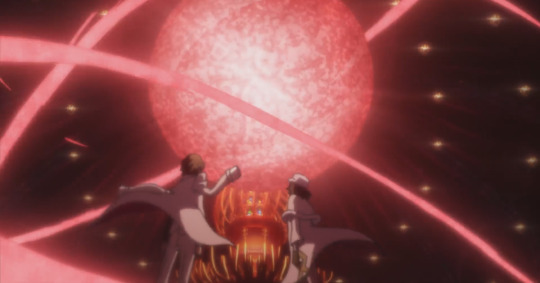
In the novel, this glowing ball of energy from the movie is actually described as an apple:
The two lights melted into one and spun until they formed a juicy sphere. They had produced a single apple — a juicy, poisoned apple red as blood.
It birthed a skill — and an extremely powerful one at that — the ability to absorb. Every last crystal adorning Draconia’s walls was sucked into the apple with intense force. Ten — a hundred — a thousand — two thousand — every last one was greedily devoured by the apple...
The apple swelled as it absorbed the numerous crystals until the red light became hotter than the surface of hell.
Since the “dead apple” motif aligns with Fyodor’s character, we can assume that the apple is representative of sin, and sin is associated with abilities, as Fyodor believes.
This strange poisoned apple is made of abilities and has an ability (the ability to absorb), and it commits a sin (greed) in its devouring of other abilities; it’s also hotter than “hell”, which is a very specific connection that leads me to this idea:
My theory is that a normal apple represents life, while a poisoned apple (or dead apple), indicative of a stained, impure life, represents sin. Fyodor believes abilities are akin to sin (what a clever rhyme), therefore all of their lives are sinful.
12. This is arguably the most insignificant change of this entire post, but I feel obligated to put it here regardless since it was different from the movie. When the Special Division detects the singularity of Shibusawa’s dragon form in the novel, it says:
“Abnormal values for singularity are increasing! They’re twice — no, 2.5 times higher than they were six years ago.”
In the movie, the number is five times higher instead.

Why did this number change? Is it significant? I honestly have no idea (I’m surprised I even caught this), but it’s there and I had to document it anyways.
13. The novel adds this narration for Shibusawa when he gets his memories back and he’s in the orphanage’s room with Atsushi:
“Shibusawa clearly recalled the events from six years ago. Fyodor had enticed him to go to the orphanage where he tortured a young Atsushi... until Atsushi fought back and killed him.”
There’s two things to take away from this: Fyodor had known Shibusawa for at least six years, and Fyodor had been planning the events of Dead Apple since at least six years ago.
I find it hard to believe that Fyodor’s plan was thwarted by Dazai, because of how Fyodor demonstrated his ability to plan ahead in the main series, but I’m not sure what the long term effects of this plan could be. If Shibusawa succeeded, then it could’ve aligned with the DOA’s goals, but once again I don’t think Fyodor’s plan was actually foiled.
14. Super minor once again, but right after Shibusawa gets revived, the last sentence of chapter 5 is,
“Nobody would ever see the smile on Fyodor’s face.”
Honestly, I think this was just added to create an ominous tone, but it’s a nice detail regardless.
15. As the red fog spreads across Yokohama, there’s a good part of exposition that connects the “dead apple” motif to Fyodor once again:
“After the red fog devoured the earth, the planet would undoubtedly look like a floating red apple from space. There would be no humans left on its surface, nor any signs they ever existed. It would be a true paradise, and with that, the Dead Apple would finally be complete. A dead planet covered in red fog — that was what Fyodor had planned and sought out.
Nothing other than death could wash away the original sin of man, so it was only fitting for the sin, which started with a fruit, to end with one as well.
It’s pretty long, but I like the way this passage is written, more specifically the last part since it fits well with the sinful poisoned apple idea.
It also aligns with Fyodor’s ideals of creating a true paradise, free of ability users. However, if Fyodor had planned to have the Earth covered in fog, that could mean that his plan was actually stopped by Dazai and Atsushi in the end.
16. Shibusawa has a few additional lines of dialogue when he talks to Atsushi in their final fight.
“The dragon and tiger... I see now why they are called rivals.”
The dragon and tiger have their roots in Chinese Buddhism, but to go further into that topic would make this already lengthy post even longer.
“Don’t get the wrong idea, though. I’m not blaming you for what happened.”
This line is a brief moment of weakness for Shibusawa, which is interesting in contrast to his strong will to kill Atsushi. Just as Atsushi learned to accept the past and the tiger’s ferocity, Shibusawa shares the same attitude by separating the blame from himself to just simply accepting the past for what happened.
17. In the aftermath of the last fight against Shibusawa, Atsushi and Kyouka meet up with Dazai.
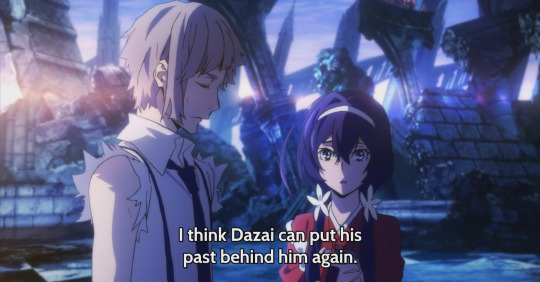
Kyouka asks, “Are you sure this is what you wanted?” which prompts two different responses in the movie and novel respectively.
In the movie, Atsushi says, “Just as Shibusawa was able to forget that he’d been killed before, I think Dazai can put his past behind him again. But this is fine.”
In the novel, Atsushi says:
“... I could probably seal away this memory just like how I’d forgotten I’d killed him before. But... I’m okay with this.”
I interpreted Kyouka’s question in the movie to be questioning Dazai’s loyalties, as he did betray everyone, and Atsushi responded in Dazai’s defense because he trusts him.
However, the novel does change Atsushi’s response to focus on himself rather than Dazai, which in turn changes the implications of Kyouka’s question.
Kyouka seems to be asking Atsushi whether he was okay with killing Shibusawa, and Atsushi responds by acknowledging that he did kill Shibusawa, and that’s okay. (a very clear development from the beginning of the story when he believed it was unnecessary to kill anyone, and he didn’t want to kill anyone)
18. In the epilogue, Ango talks about the underlying motivations behind the “Dead Apple” case. This change could be attributed to translation differences (like many others in this post), but the connotation does slightly differ from movie to novel.
In the movie, Ango says, “How is a man like Shibusawa, so intelligent that others look like alien creatures to him, to act, to be destroyed, or to be saved?”
In the novel, Ango says:
“Perhaps the two of them [Dazai and Fyodor] just wanted to get a glimpse of someone like them... Perhaps they wanted to see what he would do and how he would meet his demise... or perhaps how he would be saved.”
The movie simply poses a broad question of what would happen to Shibusawa, a person alienated from the rest of society.
The novel changes this to focus on Dazai and Fyodor’s perspective — two irredeemable aliens from society just like Shibusawa — executing this grand scheme out of curiosity to see what would happen to someone of the likes of them, and if there’s a possibility for redemption.
19. This is the final difference on this list, and it’s quite a large change. In Fyodor’s monologue at the very end of the story, he has a completely different tone from the movie to novel.
In the movie, Fyodor says, “But in order to end this world, rife with crime and punishment, I do need that book.”
The novel says:
Glittering high-rises and stately brick buildings stood side by side in this port city with its countless citizens who struggled against crime and punishment. “I think I’ve taken a liking to this city myself..” Fyodor took a bite of the apple in his hand, and the juicy nectar ran down his delicate fingers. “You’d all better be on your best behavior until next time.”
The reference to the book may have been removed for consistency with the main series, as the book is a part of the DOA’s plan (or more specifically Fukuchi).
It also seems like Fyodor has grown fond of the city, and no longer wants Yokohama to be destroyed, so it’s still possible that his plan deterred from what he had originally intended.
Beyond that, I’m not entirely sure why crime and punishment was mentioned, or why there’s such an ominous tone to his ending statement, but that’s up to personal interpretation.
That concludes the long list of extremely specific and minor differences between the Dead Apple movie and light novel!
Overall, I would say it’s worth checking out the light novel if you don’t have a strong grasp of the Dead Apple story, because it definitely presents the small intricacies of the plot in a more comprehensible way.
On a side note, the manga adaptation has a lot of noticeable differences from the movie and light novel, mostly with the addition of entirely new scenes (which you can read @buraihatranslations — what a shameless self plug). I would highly recommend reading it as those extra scenes are very amusing, to say the least without giving any spoilers.
Honestly, this post was a lot longer than I intended, but I hope you enjoyed it regardless. Thank you for reading!
422 notes
·
View notes
Text
Lost and Wins in Adaptation
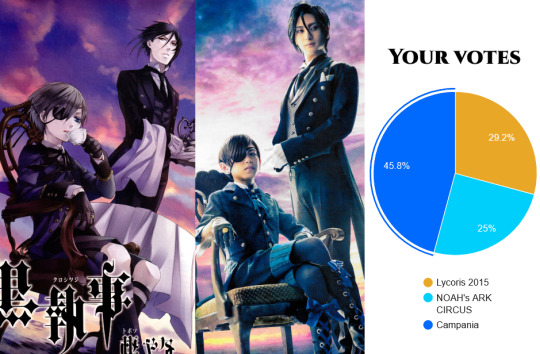
Dear everyone, as per Anon’s request, I shall analyse a Kuromyu and discuss the Lost and Wins in Adaptation. The results of your democratic votes (comments and asks) are out, and the winner is TANGO ON THE CAMPANIA! In this post I shall only be discussing character/plot influential changes, so no stand-alone comedic sketches will be included.
This is going to be a very long post because there’s just so much to unpack. But feel free to read it in bits, or skip to the part you are most interested in (but do come back later though (ÒvÓ)b). This post will include the following sections:
What makes a good adaptation?
AberHanks - Expert Glue and Filler
“Just like my family!” - One line, many messages
Grell - A Capable Career Woman
An unfortunate Sacrifice
Raw Trash Demon
Active Inclusion Midfords - Manga Fix?
Reunion and Aftermath
Afterword
I promise you the analysis will make you love TotC even more!

1. What makes a good adaptation?
2.5D wouldn’t exist without the 2D, so it is essential for any 2.5D producer to prove to the fans the producing side understood the source material using their form of medium. Changes are inevitable, but the key is that when things are changed, the core of the original needs to remain intact.
Theatre as medium’s biggest disadvantage is its strict time constraints. Whether the producers are capable of adapting a story within the time constraints without it feeling like a quickly duct-taped patchwork is what distinguishes a good adaptation from a bad one. The scriptwriters have no choice but to sacrifice parts to tell a concise story, but the art is in skillfully choosing what to yeet. The musical does need to be able to stand on its own without new audiences going “what?”, after all
2. AberHanks - Expert Glue and Filler
The most obvious difference between the original manga and Tango on the Campania is the addition of Aberline and the musical original, Hanks. In Tango on the Campania they are very cleverly employed to tie the musical together within the time constraints.

Ronald appeared before the Campania Arc, but it wasn’t before this one that he gets his own proper introduction. What the manga readers and musical-only audience have in common then, is that at this point of the story, Ronald is almost equally new. The line: “if we get to meet again, alive, that is” is a very effective way to introduce Ronald’s chipper but cynical personality. In the manga Ronald’s conversation partner was a passenger who fancied Ronald. It would have been a waste of stage time to adapt the third class setting and introduce this girl too, but skipping the line entirely would not do Ronald’s introduction justice. So the script writers cleverly used AberHanks instead, and when Ronald delivered the iconic line, the impact is still the same as in the original.

Additionally, AberHanks are supportive roles in them being police officers who help combat the zombies. The historic Titanic had a really poor survival rate, and that’s without dealing with murderous zombies. In Campania however, that’s a different story. I would argue that Aberline and Hanks evacuation efforts, along with the Formidable Midfords greatly increased the survival rate of Campania passengers.
This addition is a brilliant three-birds-one-stone move. This firstly shows that despite AberHanks being the comic relief, as the police they are not there to fool around. Secondly, by explicitly placing the Midfords along literal fighters of crime, the audience also clearly understands what the Midfords - the Chivalric order - are: fellow fighters of crime.
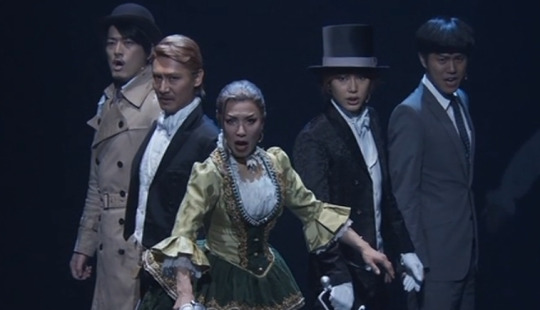
Thirdly, the gentleman’s code of evacuation is children and women first, and AberHanks would undoubtedly also have heeded that code. And yet Frances was there, and AberHanks never attempted to evacuate her or doubted her skill. The police and Frances fighting side by side shows the audience that even in the 19th century, Frances is recognised firstly as member of the Chivalric Order, before being ““just a woman in a huge dress””. Don’t mess with her.
3. “Just like my family!” - one line, many messages.
A very small but game-changing alternation is when Ciel was trying to convince Lizzie to remove her dress to benefit escape. In the manga when Lizzie refused, O!Ciel immediately rips the dress, saying that once dead she won’t be able to wear any dress, because death is the end of everything.
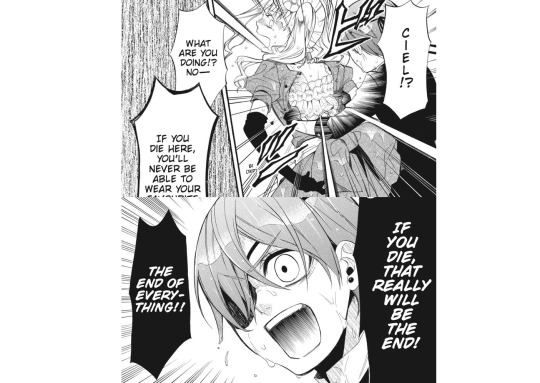
In the musical with real child actors they couldn’t very well reenact this scene, so instead they gave Ciel the line: “Everything is over if you’re dead, just like my family!”
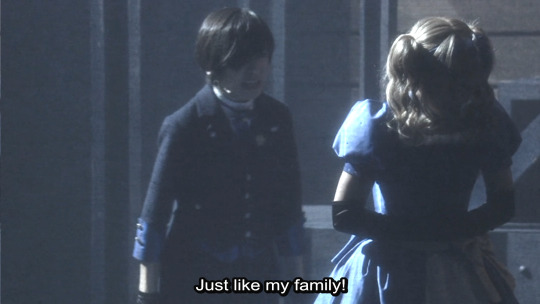
In the musical, Ciel doesn’t touch Lizzie, which is very clever. When someone refuses to remove her clothes, it is because she feels infringed, exposed and/or unsafe. If somebody doesn’t do something out of fear, what you need to do to convince them is to minimise that fear. By forcefully ripping her clothes, MangaCiel only made Lizzie feel even more infringed.
Instead of touching Lizzie, MusicalCiel appeals to Lizzie’s empathy. By making Ciel say “my family” to Lizzie, both audience and Lizzie are shown/reminded how Ciel had tragically lost his family, and cannot afford to lose more. At that time of the musical, new audiences wouldn't know yet what Ciel had been through. So when later the Cinematic Record of Sebas started, “just like my family” also functions as an effective foreshadowing of what would later be revealed, avoiding Ciel being in a cage looking like it came from nowhere to new audiences.
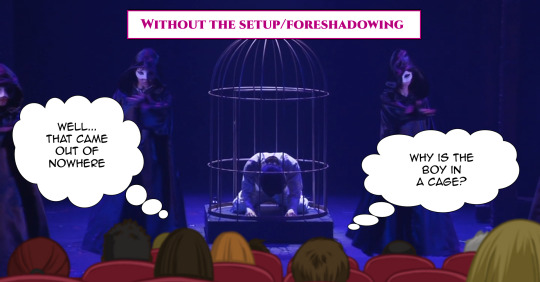
One could argue that Ciel’s phrase was emotional manipulation, yes... but it was a literal life or death situation for the objective good of everyone. And besides, we all know who our Trash Lord™ is; manipulation is part of him.
Ciel had yelled at Lizzie, and immediately he turned around, clutching his chest. It was such an impressive moment because it showed how that blow Ciel dealt was a doubled edged one. Lizzie was clearly hit too, and very quickly she realised her own fault and apologised. Then the most fun part for the audience is to consider whether this was Ciel’s genuine reaction, or whether that was all part of his acting skills in manipulating Lizzie. I say both are equally likely! (Oh Reo, you brilliant little...)

I personally consider this alteration superiour to the manga original.
4. Grell - A Capable Career Woman
Per Yana’s direct request to Grell’s actor, Uehara, she asked him to portray Grell as a capable career woman because Yana admitted she failed to do so herself.
Most of Yana’s request was fulfilled simply by Uehara’s acting and respect for Grell, but there is also one tiny line added to her script which emphasises her focus on her job. “I’m dropping you!”

Nobody on the Campania had time to fool around because it was literally going down. Grell had her job to do, and yet Rian thought it a good idea to withhold information from Grell about the method of stopping the zombies. By threatening Rian whose life was at Grell’s mercy with “I’m dropping you”, the audience is very effectively shown that Grell is a no-nonsense woman, and that she knows how to get someone to talk. 👌👌👌
5. An Unfortunate Sacrifice
Some things had to be omitted to fit the stage time limit, but the most painful omission in my opinion were details in Sebastian’s cinematic record.
A really unfortunate but understandable omission was Ciel reuniting with Tanaka and Madam Red... but considering the time constraints of the musical, shoe-horning these moments in with different actors would have come at the expense of the rest of the musical. Though very sad, it is what it is.

Another omission is Sebas forgetting to spare one assassin to interrogate. In this post I discussed in detail why this omission by the movie adaptation was such a sin. Tango on the Campania omitted that part too, though as a stage medium it is more forgivable than an animated movie with endless possibilities Ò^Ó. Nevertheless it is a bit sad, because this omission takes away that the audience can see how Sebas was just so used to massacring on auto pilot, and how even Sebas himself recognises he needs to learn control.

THOUGH, I must say the musical actually tries to compensate for this shortcoming, unlike the movie. This omission of what showed that Sebas was far from perfect at the beginning, Furukawa compensated by simply being the most insincere, passive-aggressive, unprofessional, arrogant prick he could be.
The audience won’t catch a hint that Sebas used to be no more than a weapon, but they will see how Sebastyun never served a human on close proximity before!
6. Raw Trash Demon
I have already talked about how Sebastyun is a real game-changer on this blog, so I will not repeat every detail again. So here I will only address the significant changes in spoken lines that add to Sebastian’s character before he was fully trained. In this post I discussed in detail how Furukawa portrayed Sebastian’s gradual growth from raw demon to one hell of a butler. Sebas at the beginning was really butler in appearance only, as he was insolent and never knew when to shut his wondrous trap.

In stage format it would have been quite awkward to do a bath scene, so instead the creators replaced it with a wound-dressing scene. Instead of pouring hot water over the boy, Sebastyun is now scrubbing his master’s skin off. When the boy protests, rather than immediately apologising like his manga counterpart did, Sebastyun just shoves the feedback right back down the boy’s throat. “You’re making too much of a big deal out of it.” Here we see how Sebas is not there to serve his master, he’s just doing his thing because he has to.

Another line that is musical only is when Ciel’s stomach rumbled, and Sebas laughed his arse off, saying: “what an inglorious sound!” In the manga Sebas started a high-horse speech about human weakness, which was quite bold already. But he did not seem to dare straight up humiliate his master for a basic bodily need.
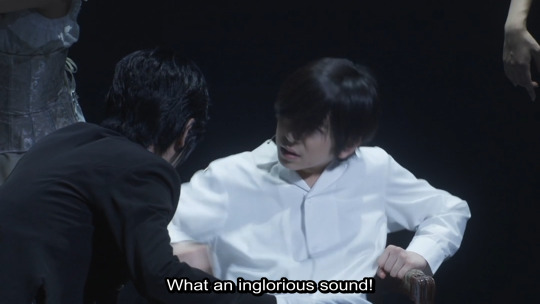
Sebastyun however? Balls of steel.
He humiliates his master, can’t apologise for shit, and when he says things in compliance with his master, it’s in a tone of: “well, screw you too”. Sebastyun was so bad at his job that Ciel too was given another line that wasn’t in the manga: “The preparations of a day’s meals is part of a butler’s job”.

Sebas had just criticised his master for being a useless kid, and now Ciel makes a comeback with the line: “well, you don’t even know what your literal job is, let alone how to do it.” The addition of this line is very powerful in my opinion, because it quite effectively compensates for the omitted scenes of Ciel and Sebas both sucking at their respective roles.

When O!Ciel commented on Sebas’ awful cooking, MangaSebas seemed quite willing to do his job well, and immediately offered to fix his mistake. Sebas does not apologise, but he does show that he made a mistake in not being considerate enough of Ciel’s current condition.

Sebastyun however, couldn’t apologise for shit at the beginning. Instead of showing openness to feedback, he immediately externalises by making humans the problem again, rather than his own lack of cooking skill. No wonder Ciel smashed that table with such aggression!
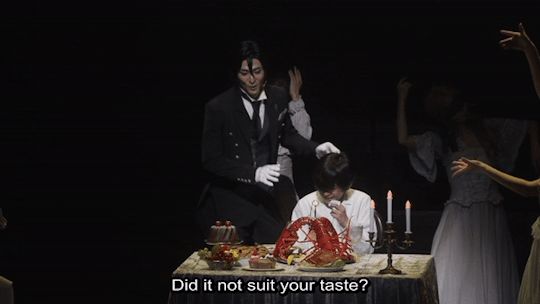
Another changed line is Sebas bringing his master hot milk after his failed dinner attempt. Originally Sebas did so potentially as an attempt to show his readiness to do better at his job. He explains that he does so out of consideration for the well-being of the boy.
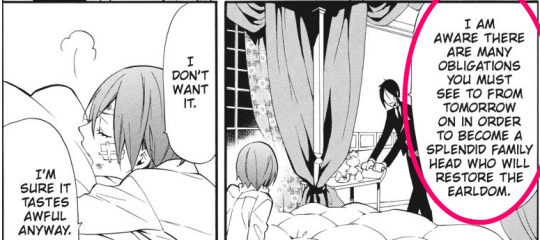
In the musical however, Sebastyun does not say the manga line. Instead he says: “I can’t afford to have you starve to death.” I am not sure whether this was the script or Furukawa’s improvisation, but either way it perfectly shows yet again, how Sebas is not there to serve his master, but to just get his tasks over with.
This is a very short but efficient alternative way to retell how Sebas especially at the beginning was not very enthusiastic about being summoned, as analysed here from the original Japanese manga. Sebas is not like: “(UwU) gimme more orders”, he’s like: “(ಠ_ಠ) what is it this time?”

A small addition that was definitely an improvisation was Sebastyun sitting down on Ciel’s bed, and the boy pushing him away. (At the beginning of the run Furukawa didn’t do that yet. The first time Furukawa sat down Reo just moved aside and gave Sebas a nasty look.) Here it also reemphasises how little Sebastian understood of what was done and NOT done as a servant.
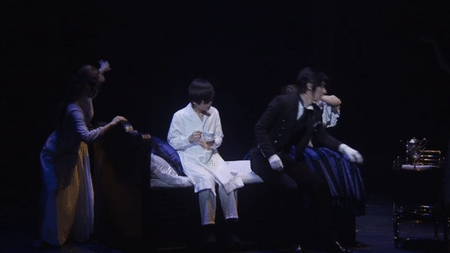
A final, noteworthy addition in the far beginning of their contract was Ciel saying that he acknowledges both he himself are the demon are still fakes. The boy says this line after Sebas had brought him hot milk which Ciel appreciated.

Ciel calls his butler forward in a soft tone, and Sebastyun just looked so self-congratulatory, self-satisfied, he adjusted his suit, standing all ready like: PRAISE ME! (●´ิ∀´ิ●)✨

Yeah no... you wish.
In the manga this line doesn’t exist, so Sebas is simply surprised to hear the compliment, and then his master just splashes the cold water right over him.
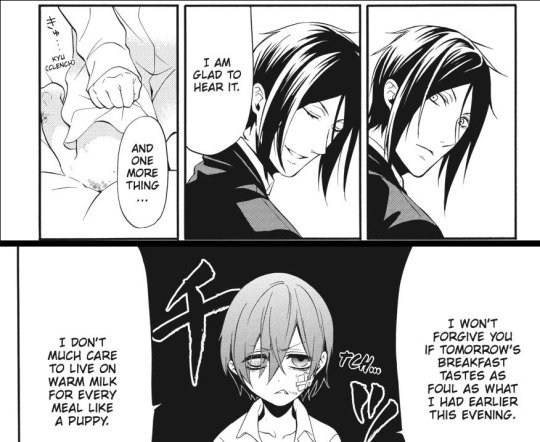
7. Active Inclusion Midfords - Manga Fix?
The most dramatic and influential change to the musical is the active inclusion of the Midfords. It is an entire scene that was added to the musical, so it is a bit impossible to unpack everything in this already very long post. So here I will only address the most game-changing alterations.
Yana Beaten to the Punch, strike 2 and 3?
Now many chapters later than the Campania Arc, we know that the Midfords had been the legal guardians of Ciel after the death of his family. But even before the release of the chapter, we’d see in Sebastyun’s Cinematic Record how the Midfords were very involved with their nephew. This shows how much respect for the manga the musical producers had, and how well they understood their source material that they too could beat Yana to the punch. Strike 2!

Both Midfords were present before and during the decoration ceremony. And Sebas bows deeply, thanking them sincerely for their aid all this time. Sebas cannot lie, so when he says “sincere gratitude”, it really was sincere. Alexis responds humbly, saying that it’s simply the right thing to do.

Not only did the Midfords aid Ciel in his reintegration into the world, Frances also showed the audience and Sebas she knows exactly what she is preparing the child for. Frances says she understands how cruel it is for the young Ciel to do what is expected of him, because being Earl means more than wealth and power. It is: “shouldering the burden and name of ‘the Queen’s Watchdog’.” The musical also does a great job at linking Frances’ position as the previous Watchdog’s sister, to being the legal guardian of the future Watchpuppy.

I have seen many manga readers talk about how they found Frances’ involvement insufficient in the manga, and I understand. She has a very small role in the manga, so we don’t know what she has or hasn’t done to help. But in Tango on the Campania, we do get a much clearer sense of the Midfords’ role in Ciel’s life.
Ciel was still mid-preparation before the start of the Ceremony, but Frances and Alexis had already arrived to keep a parental eye on him.Ciel is surprised, but Frances responds with: “it would set a bad example if the star is late”. Though it is but one short phrase, the script writers shows (not ‘tells’) how she is there because she wants to make sure Ciel’s decoration will go smoothly, as well as that her own role is to set an example for Ciel by being on time herself.
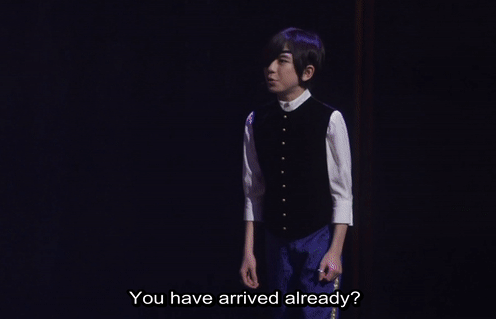
This is possibly a reference to what Sebas says to Frances in chapter 14, how he wishes her to be his master’s example. Except that here in the musical, it is Frances who takes this initiative, which in my opinion is the superiour way.
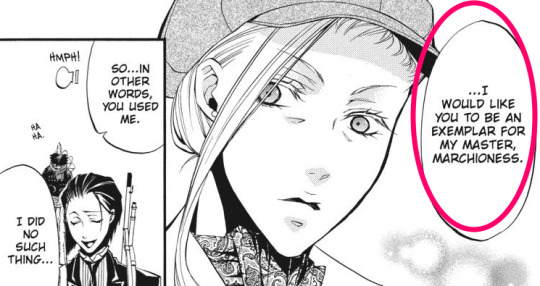
When Frances commends Ciel for his courage of returning to fight, Sebastian adds: “The most opportune chance for counter attack is when the opponent strikes. That is what milady Frances had taught him, the Young Master said.”
To which Frances is quite surprised to hear, and incredulously she says: “Ciel said that?” This makes one suspect whether Frances really said those words to supposedly Real Ciel. It would be very funny if Sebastian (accidentally) gave Frances a hint of his master’s real identity. I am not sure whether this is an implicit hint that Frances might have started suspecting Ciel is not the Real Ciel. Some have theorised Frances has the deepest suspicions among everyone. If that turns out to be true, then TotC might have beaten the original manga to the punch again. Potential strike three!

Another change is the replacement of Madam Red with Alexis. This one is just a very pragmatic change, because the phrase “To Ciel you are already as good as family” is very iconic and important and shouldn’t be left out. But getting a Madam Red in here out of nowhere would require time-consuming exposition. So by giving this phrase to Alexis instead, the musical effectively solves two problems in one go.

8. Reunion and Aftermath
Another addition to the original manga is the reunion on the rescue ship, just like the the movie adaptation of the Campania Arc did. After all that has happened it is very nice for the audience to see the emotional reunion and the aftermath. In the manga the Arc ended with Sebas and his master on the rescue boat, and it had a very nice, open feeling to it, I absolutely love it! 💖🚤
Audience Considerate Story Telling
To a musical-only audience (which TotC had a lot of because of the collaboration with TOHO), the opening ending might have felt a bit abrupt. These musical-only spectators don’t have the Arcs after the Campania to know for sure Sebas and Ciel went home safely, and that life would just continue. Nor would they know for sure what kind of impact the enormous revelation of Undertaker being a reaper would have on our protagonists. Had the non-manga audiences been given the same ending as the original, then it might have looked a bit like this to them.

Also considering the musical medium, any (Japanese) audience would want a satisfying finale song to wrap everything up. (Kuromyu21 not having one was a real complaint among JP spectators). And after the dramatic brawl song of Sebas fighting the zombies on that boat, you can’t very well pull another song on that tiny thing again. Okay, the song TotC did settle with for the finale song was......very disappointing in my opinion as it reminded me more of a Disney parade, but it at least had a song.

Emotional Full Circle
Despite the song being quite unfitting, the emotional reunion really, REALLY hit hard. When Lizzie says “welcome back” to Ciel, it was a perfect full circle back to what Lizzie couldn’t do 3 years ago.
In her flashback of 3 years ago when Ciel returned to her, the boy lifelessly said: “I’m back... Elisabeth”. Lizzie however never responded with “welcome back” because she was too preoccupied with something just feeling off.

In the musical reunion however, unlike 3 years ago Lizzie was fully emotionally equipped to genuinely welcome her fiancé back, and Ciel too happily responds: “yeah, I’m back, Lizzie”, using Lizzie’s preferred name.
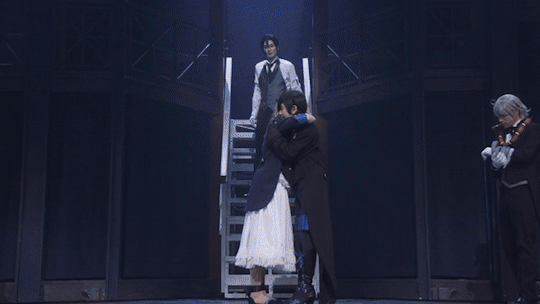
Sebastian’s Aftermath
The reunion is but a simple addition, but it allows the musical to show the impact of such a traumatic event on the omnipotent demon butler.
The Cinematic Record showed how cocky Sebastyun was, and how he didn’t have a single worry in his life. After Undertaker had fatally wounded even the demon however, Sebas became a different person. In the finale we see Undertaker silently disappearing into the shadows. Sebastyun wasn’t even entirely sure whether Undertaker was there, but at the merest suspicion already you see him flinch and twitch. This shows how from now on Sebas has become a person who is on edge.
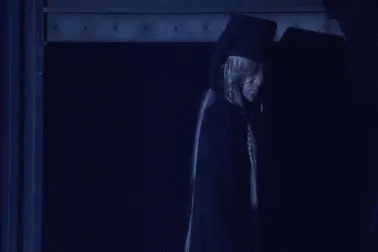
I mean, what’s the point of telling an event if the event doesn’t impact the story and characters, right? In this way too, the inserted aftermath scene skillfully wraps up an overwhelmingly eventful story.
9. Afterword
Well, thank you for reading this looong post till the end! As discussed in this post, TotC did a wonderful job at adapting an existing story with consideration of its audience and medium.
The largest obstacle of the theatre medium is time constraint, so the makers have to sacrifice parts. In what was sacrificed however, they more than sufficiently compensated by including parts outside the Campania Arc into the musical, without harming the integrity. This shows just how much respect and knowledge the TotC team have of the source material.
As a musical adaptation, it is an exemplary production.

Related posts:
Hyper Detailed Development - The Art of Kneeling
That Demon, Skin Crawling
That Butler - Punchable
Lost in Translation II - Sebastyun’s Butlernese
#Kuromyu#Comparative analysis#Tango on the Campania#Campania#Musical#Sebastyun#Furukawa Yuta#Uchikawa Reo
135 notes
·
View notes
Text
Does Bing gē Have Descendants in ‘The Untold Tale?’
This topic has come up a few times since The Untold Tale takes place in the PIDW universe (post-Bingge vs Bingmei extra), I figured I might as well compile and archive my official answer here for me to refer my AO3 readers to in the future for convenience’s sake. I hope everyone doesn’t mind. :) I’m always happy to answer questions!
TL;DR
Q: Will we see Bing gē having fathered children with his harem of 600 or so wives in TUT?
A: For TUT, the answer is a definite “no.” There were a lot of factors which’d contributed to my decision. I’ll try to explain my reasoning down below.
Context
In PIDW, it is canon that Luo Binghe has a bountiful number of descendants with his harem of 600-or-so wives. It is a detail that has been mentioned even in ch1 of SVSSS and in ep1 of the donghua.

(SVSSS Excerpt - ch1)

(SVSSS donghua - ep1)
I like to plan things ahead of time. So from very early on, I knew this would be something I would have to decide on whether or not to address when I’d finally decided to expand TUT from just a prologue into a full-blown story. And after contemplating it, I decided against adding children into the story. It is because 1) it would make the situation more complicated, and 2) it would take TUT in a different direction that wouldn’t be fun for me to write.
I’m a very decisive writer, meaning when I make my mind up about something, chances are I won’t change my mind. This is because I would have already planned it into my plot outline, which means changing a decision would require me to change other details in the other chapters I have planned for that story. (I’m typically not a spontaneous writer; I try not to write spontaneously because when you’re a writer who rotates through multiple WIPs with different characters across different genres or writing styles, you inevitably have writer’s block because you probably won’t remember all the ideas or the direction you had whenever you return back to a different WIP. To reduce this shortcoming, it helps me personally to have a plot outline. This way I can return to any WIP, read my notes and then transcribe them into legible paragraphs, find a way to transition between the story beats I have to hit for that chapter, and then eventually post the final draft to AO3 when I feel it’s ready.)
Having made a decision, I knew I had to set it up in TUT and give a “reasonable explanation in-story.” Hence, in ch2, we see:

(Excerpt I - ch2)
Basically the set-up is TUT takes place post-Bingge vs Bingmei, but between “the third or fourth book” of the hypothetical PIDW webnovel series aka before Airplane wrote the fanservicey chapters where the luckier of LBH’s wives give birth to children during the harem drama plots and the children are probably rarely, if ever, mentioned again in the story as a lot of stallion novels tend to do.

(Excerpt II - ch2)
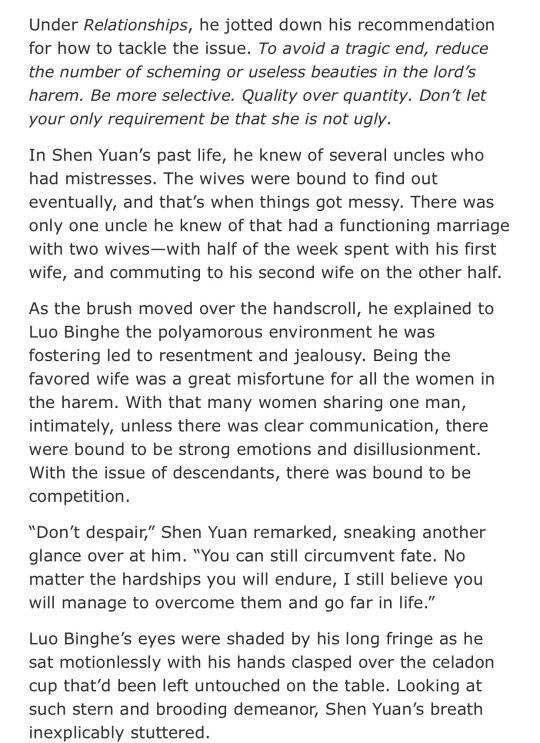
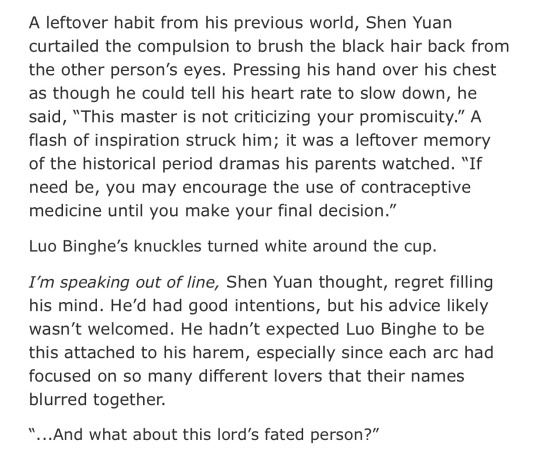
(Excerpt III - ch2)
Contrarian Tendencies
You know the saying: Monkey see, monkey do? In my case, it’s monkey see, monkey do not do.
A little fun fact about me as a writer: if I have already seen a fanfic where someone has already written a concept or idea into their story, chances are I will just avoid it entirely in my own stories. I don’t know why this aversion exists, but I’m assuming it’s because of my counterculture hipster inclinations and an intrinsic fear of plagiarism which has been beaten into all of our skulls since adolescence. There’s nothing wrong with being inspired by other people’s works. Technically everything’s been done before in writing so, as a writer, a good rule of thumb is to always try to give it your own unique spin on things. So for me, my brain somehow interpreted this a step further. This is a reason why I try to avoid reading stories from whichever fandom my WIP is from during the writing process of updating a fic, because this is how I get influenced. Once I see an idea or interpretation from another fanfiction, it influences me to not want to write it into my own. This is a very strong unconscious impulse for me. I guess this is just the neurons in my brain’s thinking that this way, it won’t be something my readers will have read before and the story idea will come across as different or fresh, and mine. In a way this is also how I show respect for fanfiction writers in the same fandom—by being inspired to not be inspired, ha. I like to think every story in the world serves a niche audience, so seeing a diverse range of originality and interpretations in a fandom is a good thing. This is also how I feel when I am able to identify certain popular tropes or depictions or patterns in a fandom; 99% of the time, it makes me feel a compulsion to “go against the grain” or write the opposite. For example, you have no idea how long it took me to come around the idea of incorporating the fanon “A-Yuan” into TUT. However cute it is, the moment it dominated the fandom (well, “dominated” is an exaggeration; it’s more like I’ve seen enough, especially in the Original LBH/ SY | SQQ tag), my gut reaction was to nope out of using it. But after seeing a lot of comments in my inbox with readers affectionately calling SY “A-Yuan,” I’d contemplated it for a long time and it wasn’t until ch4 that I decisively decided that yes, I can have Bing gē calling SY “A-Yuan” in TUT—but it has to be at the right moment for maximum dramatic and emotional impact. (See this thread that started it all. And this is the small sneak peek I wrote where LBH will call SY that for the first time.) <- This is the rare 1% where I actually conformed to what’s popular.
In this case, when I finally decided to expand the prologue into a full-blown story, coincidentally I had just recently read a good Binggeyuan (Bingyuan) fanfic which featured a kidnapped Shen Yuan interacting with Bing gē’s harem and LBH’s children/descendants. I’d liked their portrayal and even thought the children were cute. <- However, with me having reading this, the problem came up: I felt the familiar stubbornness in me rearing its head. So knowing myself, if I had included children, it is very likely the direction that I would have gone down for TUT would have been the opposite. To further complicate matters, you have to keep in mind the kind of writer I am. I tend to like grounding stories with a semblance of realism, no matter if the genre is pseudohistorical fantasy, romance, sci-fi, etc. And this writer has seen and read quite a few harem and palace intrigue Chinese dramas/ premises.
For further context, in those types of “historical” C-dramas^, in that sort of environment which fosters scheming, competition, jealousy, etc, it is almost expected to see heirs aka children aka descendants harmed along with the women. Innocent parties are often victims in these sorts of cutthroat premises, to underscore the underlying message the show or novel wishes to present. (See Ruyi’s Royal Love in the Palace. See Yanxi Palace. See The Legend of Haolan. See Nirvana in Fire. See The Rebirth of the Malicious Empress of Military Lineage. Etc.) And me being me, this would be the direction I would take. Remember, while TUT is meant to emulate a legitimate danmei C-novel reading experience in a fantasy world, I do drop pseudohistorical and cultural Easter eggs into the story. So trust me when I say you would not like the direction TUT would have gone down in, had I made LBH have children with his harem. I mean, theoretically yes, we could’ve seen endearing children characters from me, but you would have also seen me addressing a lot of the baggage that comes with (see Comment III Excerpt down below).
The situation with dissolving Bing gē’s harem is already complicated enough. As his romance with Shen Yuan develops, I didn’t want to have an additional headache thinking about how to address the issue of LBH having children already. Divorces in a pseudohistorical context is already a heavy topic—even more so when it’s divorces with children in the mix. Naturally I will still have SY and LBH eventually discuss the matter of legitimate heirs since LBH will essentially become the Sacred Ruler of all Three Realms and it’s a traditional precedent for an emperor to bed his empress, noble consort, and imperial concubines until he has his heirs (plural, because the rate of mortality was high in ancient China). In TUT’s case, at that point in the story SY will remind LBH that he’s essentially an immortal sovereign so there isn’t any need for an heir unless he wishes to retire. Furthermore, he will inform LBH that he could set a new precedent since he’s already different from the other emperors from history (with him being of half-Heavenly Demon and half-human cultivator lineage); as long as LBH is fully aware of all perspectives of the situation, he doesn’t necessarily need to conform to all traditions if this is something he really feels strongly about. But this future conversation(s) is likely the extent of it.
But wait, you say, what about a certain someone who’s going to be transmigrated as an imperial crown prince? Isn’t he going to be in that sort of vicious upbringing? <- Yes. But that’s an entirely seperate matter. In a way, since I’ve decided Bing gē will not have had any children or descendants in TUT, with Airplane, this now presents an opportunity for me to show the consequences of being one of the many children of an emperor with a harem of women vying for one man’s attention—and the power struggle that’d ensue in this kind of environment. It’s an interesting What-If parallel, if you think about it.
AO3 Comments
Although these are just small excerpts from replies I’ve written before, it’s nice and orderly to just compile them here for everyone since these will be buried underneath all the comments as TUT updates:
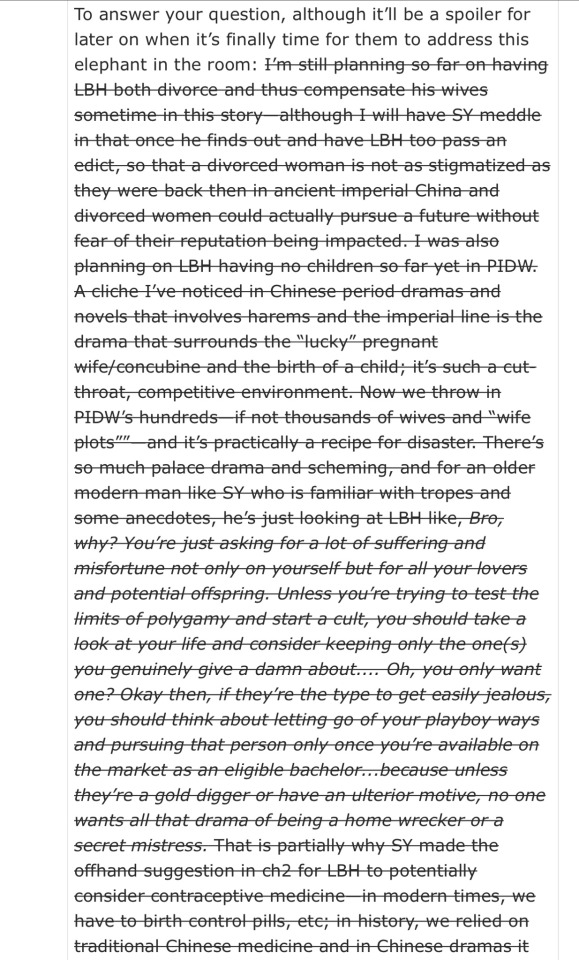

(Comment I- ch3)

(Comment II- ch4)
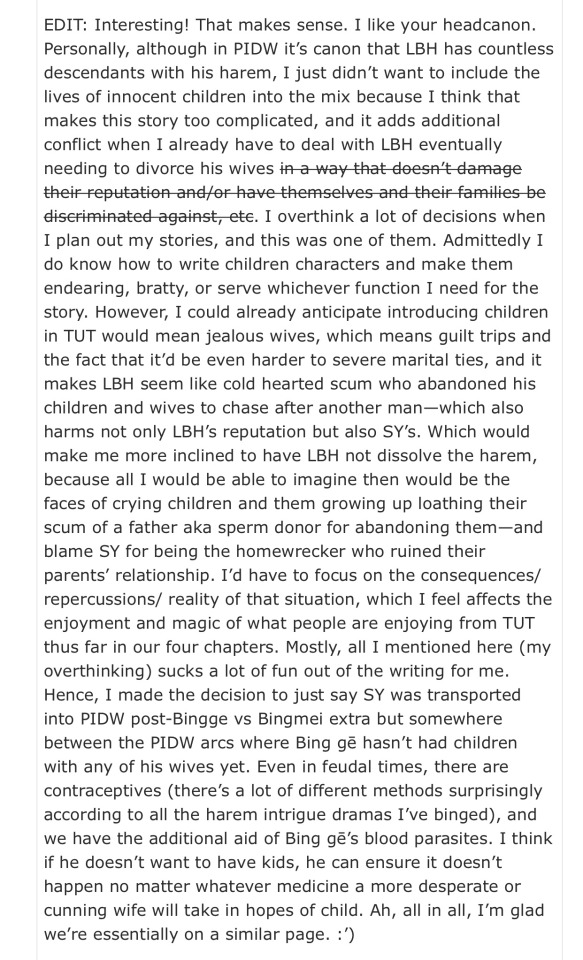
(Comment III- ch4)
Because of seeing comments that have asked me for my thoughts on whether or not I will include LBH’s children, I’ve had so much fun seeing theories thrown around: from LBH’s blood parasites being able to control conception, to someone’s headcanon about LBH being a hybrid and all that entails scientifically (think: mules). I will say in TUT, it’s more the former since in PIDW he’s supposed to have descendants; we’re pretending Bing gē doesn’t have any yet (and now definitely won’t, especially after having heard SY’s “prophecy”) because he subconsciously does not want children due to certain fears, trauma, etc. And his Heavenly Demon’s “blood parasites” (blood manipulation) is a convenient story device to explain why no wife has gotten pregnant yet.
I hope this explanation makes sense! Mainly I just wanted to have this archived on tumblr so that I have this post to refer to moving forward.
On a side note: especially since ch4 had been posted, quite a few people have actually mentioned they’ve read my replies to other comments and/or I have seen different people having hopped onto other readers’ comment threads (for example, imagine my pleasant surprise when I saw a reader you lovely person, you helpfully jumping in to respond to another reader’s questions about TUT, and their answers were actually aligned with what I would’ve answered!), so it’s always such a thrill whenever I see this level of engagement happening. I can’t explain why, but seeing this happening is just so cute to me. It really makes this writer feel so warm and fuzzy inside!
#svsss#bingyuan#bingqiu#the scum villain's self saving system#luo binghe#the untold tale#phoenixtakaramono#ask#technically not an ask#but i like to categorize it there#I mainly wrote this lengthy explanation on tumblr#bc I wanted to link this as ref#anytime someone asks me in the future regarding LBH’s kids#lol it’s actually not cinnabar pills hidden in a bracelet#it’s some sort of seeds which supposedly stopped concubines from being pregnant#I discovered this when I rewatched Ruyi’s Royal Love in the Palace#Do you all notice you have a unique writing syntax/ style#that’s how I can identify that you’re all diff ppl in the comments#one time an anon guest wrote something for G&G#and in the comment thread as another guest anon they supposedly agreed with the prev anon#in that case it was obvious it was the same person pretending to be another guest anon#and I can tell because their writing syntax/ voice is identical#which is why I’m so pleasantly surprised to see this phenomenon in the SVSSS fandom#you all have diff writing syntaxes#seeing you all interact with each other’s comments or my comments to other comments#is just such a delight ahhhhhh#I love the SVSSS community#you guys are so warm and welcoming
35 notes
·
View notes
Text
New Colin Morgan Interview with Edge Media Network about Benjamin - UPDATED
I am reblogging this because, after the author was made aware of an error in the posting of his article (if anyone clicked through to read it on the site, there was a whole question and answer that was repeated), the error was corrected and another three questions and answers were added! I am correcting it here, but they were very interesting, so I suggest you read the full article again!
I shall post the link at the bottom, but I wanted to type it out so that non-English speakers could more easily translate it. (This article was listed in their “Gay News” section of the site, hence the focus on the gay roles.)
British Actor Colin Morgan: How the Queerly Idiosyncratic ‘Benjamin’ Spoke to Him
by Frank J. Avelia
In writer-director Simon Amstell’s sweet, idiosyncratic, semi-autobiographical comedy, “Benjamin,” Colin Morgan plays the titular character, an insecure filmmaker trying to resuscitate his waning career (at least it’s waning in his mind) after one major cine-indie success. Benjamin is also doing his best to navigate a new relationship with a young French musician (Phenix Brossard of “Departures”).
Thanks to the truly endearing, multifaceted talents of Morgan, Benjamin feels like an authentic creation--one that most audiences can empathize with. Sure, he’s peculiar, has a legion of self-esteem issues and an almost exasperating need for acceptance as well as an inconvenient talent to self-sabotage the good in his life. But who can’t relate to some or all of that?
“Benjamin” is one of the better queer-themed films to come out in recent years, in large part because it eschews emphasis on the queer nature of the story. Instead, the film is a fascinating character study with Morgan slowly revealing layers and unpacking Benjamin’s emotional baggage.
Morgan is a major talent who has been appearing across mediums in Britain for many years. His London theatre debut was in DBC Pierre’s satire, “Vernon God Little” (2007), followed by the stage adaptation of Pedro Almodovar’s “All About My Mother” (2007), opposite Diana Rigg. Numerous and eclectic stage work followed (right up until the Corona shutdown) including Pedro Miguel Rozo’s “Our Private Life” (2011), where he played a bipolar gay, Jez Butterworth’s dark comedy, “Mojo” (2013), Arthur Miller’s “All My Sons” opposite Sally Field (2019), and Caryl Churchill’s “A Number” (2020), to name a few.
His TV work includes, “Merlin” (playing the wizard himself), “Humans” and most recently, in a very memorable episode of “The Crown”. Onscreen he can be seen in “Testament of Youth”, “Legend” with Tom Hardy, “Snow White and the Huntsman” and Rupert Everett’s take on Oscar Wilde, “The Happy Prince.”
He’s played a host of gay roles in the past on stage, screen and TV.
EDGE recently interviewed the star of “Benjamin” about the new film and his career.
Why Benjamin?
EDGE: What drew you to this project and were you part of its development?
Colin Morgan: It’s always the strength of the script for me on any project and Simon’s script was just so well observed, he managed to combine humor and poignancy in delicate measure and when I first read it I found myself being both tickled and touched. Then reading it again and from “the actor” POV... I knew it would be a real challenge and uncharted territory for me to explore. I auditioned for Simon and we tried it in different ways and then when I was lucky enough for Simon to want me on board, we began to work through the script together, because it was clear that this was going to be a very close working relationship... it was important for the level of trust to be high.
EDGE: I appreciated that this was a queer love story where the character’s queerness wasn’t the main focus. Was that also part of the allure of the project?
CM: I think Benjamin’s sexuality is just quite naturally who he is and therefore that’s a given, we’re on his journey to find meaning and love and there’s certainly a freshness to what Simon has written in not making sexuality the main focus.
Great chemistry
EDGE: Can you speak a but about the process involved in working with Amstell on the character and his journey?
CM: Simon and me worked very closely over a period of weeks, at that time prior to shooting I was doing a theatre project not far from where he lived so I would go to him and rehearse and discuss through the whole script all afternoon before going to do the show that night, so that worked out well. It’s so personal to Simon, and to have had him as my guide and source throughout was fantastic because I could ask him all the questions and he could be the best barometer for the truth of the character; a rare opportunity for an actor and one that was so essential for building Benjamin. But ultimately Simon wanted Benjamin to emerge from somewhere inside me and he gave me so much freedom to do that also.
EDGE: You had great chemistry with Phenix Brossard. Did you get to rehearse?
CM: Phenix is fantastic, Simon and me did chemistry reads with a few different actors who were all very good but Phenix just had an extra something we felt Benjamin would be drawn to. We did a little bit of rehearsal together but because it was a relationship that was trying to find itself there was a lot of room for spontaneity and uncertainty between us, which is what the allure of a new relationship is all about, the excitement and fear.
Liberating process
EDGE: Did your process meld with Amstell’s?
CM: I’ve said this a lot before and it’s true, Simon is one of the best directors I’ve worked with. Everything he created before shooting and then maintained on set was special. We always did improvised versions of most scenes and always the scripted version too. It was such a creative and liberating process. That is exactly the way I love to work. And for a director to maintain that level of bravery, trust and experimental play throughout the whole shoot stands as one of the most rewarding shooting experiences I’ve had.
EDGE: When I spoke with Rupert Everett about “The Happy Prince,” he very proudly boasted about his ensemble. Can you speak about working with Rupert as he balanced wearing a number of creative hats?
CM: Again, this was an extremely rewarding project to work on and quite a similar relationship as with Simon in the respect that Rupert was the writer/director and Oscar Wilde is so personal to him. And then we also had many scenes together in front of the camera, so Rupert and me had a real 3D experience together. It was a long time in the making. I was on board, I think, two years before we actually got shooting so I had a lot of time to work with Rupert and rehearse. He really inspired me, watching him wear all the different creative hats, such a challenging and difficult job/jobs to achieve and he really excelled--plus we just got on very well.
Playing queer roles
EDGE: You haven’t shied away from playing queer roles. Do you think we’re moving closer to a time when a person’s sexual orientation is of little consequence to the stories being told, or should it always matter? Or perhaps we need to continue to evolve as a culture for it to matter less or not at all...
CM: That’s a hard question to answer, I think certainly the shift in people’s attitudes has changed considerably for the better compared to 40 years ago, but there will always be resistance to change and acceptance from individuals and groups whether it be sexuality, religion, race, gender--we’re seeing it every day.
Evolution is, of course, inevitable, but if we can learn from the past as we evolve that would be the ideal. Unfortunately, we rarely do learn, and history repeats itself.
EDGE: You were featured prominently in one of my favorite episodes of the “The Crown” (”Bubbikins”) as the fictional journo John Armstrong. Can you speak a bit about working on the show and with the great Jane Lapotaire?
CM: I had an exceptionally good time working on “The Crown.” Director Benjamin Caron, especially, was so prepared and creative, and made the whole experience so welcoming and inclusive. It was an incredibly happy set, with extremely talented people in every department, and I admired the ethos of the whole production and have no doubt that’s a huge ingredient to its success, along with Peter Morgan’s incredible writing.
I was also a fan of the show, and it was an honor to be part of the third season. And I can’t say enough amazing things about Jane Lapotaire. We talked a lot in between filming, and I relished every moment of that.
EDGE: You’ve done a ton of stage work. Do you have a favorite role you’ve played onstage?
CM: I’ve been so lucky with the theatre work I’ve done, to work with such special directors and work in wonderful theatres in London. I’ve worked at the Old Vic and The Young Vic twice each, and they’re always special to me. Ian Rickson is a liberating director, who I love. It’s hard to pick a favorite, because the roles have all been so different and presented different challenges, but, most recently, doing “A Number,” playing three different characters alongside Roger Allam and directed by Polly Findlay, was a really treasured experience, and I never tired of doing that show, every performance was challenging as it was.
Miss the rehearsal room
EDGE: You were doing “A Number” earlier this year. Did you finish your run before the lockdown/shutdown?
CM: Just about! We had our final performance, and then lockdown happened days later. I feel very sorry for the productions that didn’t get the sense of completion of finishing a run. I mean, finishing a full run leaves you in a kind of post-show void anyway, even though you know it’s coming, so to not know it’s coming and have it severed must be even more of a void.
Memories of performing just months ago seem like such an unattainable thing in this COVID world right now. I can’t tell you how much I’m hoping we get back to some semblance of live performance.
EDGE: What was it like to appear onstage opposite Dame Diana Rigg in “All About My Mother?”
CM: Well, I think “iconic” is an apt word for both the experience of working with Diana and the lady herself. In between scenes backstage we used to talk a lot and we got told off for talking too loudly, so Diana began to teach me sign language and we would spell out words to each other, maybe only getting a couple of sentences to each other before she was due on stage and I had to get into position for my next entrance-- we did a radio play together two years ago and she remembered, she said, “Do you remember A-E-I-O-U?” signing out the letters with her hands.
EDGE: None of us knows the future in terms of the pandemic and when we might return to making theatre. I’m a playwright myself and find it all supremely frustrating but I’m trying to remain hopeful! Where are you right now in terms of the standstill we are in and what the future might hold?
CM: Yes, I’m so worried for theatre. It’s a devastating blow. I’m sure as a playwright, you know that the creative spirit in individuals hasn’t been diminished by this virus. People are creating important art in this crisis but we need the platforms to present it and bring people to some light again out of this really scary period, but it needs to be safe and it’s a worrying time. The virtual theatre approach must be looked at I think. We need to experiment and find new paths at least for the time being. I’m involved in developing some things right now and how we can work on things in both an isolated and collaborative way. It’s entirely counterintuitive to what the family-feel and close bond of a group in a rehearsal room is like-- I miss the rehearsal room so much!-- but we can’t sit still, we must create and we must act.
What’s in a role?
EDGE: Looking back on the great success of “Merlin,” what are your takeaways from that experience?
CM: Some of the most treasured memories of my life will forever be connected to “Merlin,” the cast, crew, production, everyone! The invaluable training of being in front of a camera every day! The chance to inhabit a character and live with him for five seasons! There’s too much to list and words probably won’t do justice anyway, but I’m truly grateful for everything the show gave me.
EDGE: How do you select the roles you play?
CM: I guess they select me in a way. I can’t play a role unless it speaks to me and provokes me in some way, but ultimately it’s the characters that I have a fear about playing, not knowing how I’m going to enter into the process of living them, when I don’t have all the answers it’s a good indicator of a character I must play. If I have all the answers, there’s less scope for exploration and discovery which isn’t as interesting for me.
Link here
149 notes
·
View notes
Video
youtube
We’re talking about adventure games again! Or, more accurately, we’re speaking in the context of adventure games about why some genres are hard to define, different ways of thinking about genre, and what genre is even for.
If you'd like to see more work like this, please back me on Patreon! Transcript below the cut.
Hi! Welcome back to Who Shot Guybrush Threepwood? Meditations on the life, death, and rebirth of the adventure game.
Adventure game.
Adventure game.
Ad. Ven. Ture. Game.
What kind of name is that, “adventure game”? It’s an atypical way of categorizing video games, I’ll say that much. We usually give game genres titles like "first-person shooter," "real time strategy," “turn-based role-playing game.” Real nuts-and-bolts kinda stuff. Meanwhile, "adventure" seemingly belongs on a turnstyle of airport paperbacks, in between "mystery" and "romance." When they slap that word on a game box, what is it supposed to communicate to us?
Other one-word genres, I can see how they get their name. A horror game is horrifying, a fighting game earns its title. But how is exploring an empty, suburban house an adventure? Why is exploring a universe not?
When I started this series, I offered up the rough-and-tumble definition of adventure game, “puzzles and plots,” and said maybe we’ll come up with a better definition later. That was… four years ago. Sorry about that. I know it’s a little late, and a lot has changed, but I did promise. So we’re gonna do it.
Today’s question is: What makes an adventure game an adventure game?
This is a tricky sort of question to ask, because, upon asking, we might stumble down the highway to “what makes an adventure novel an adventure novel?”, “what makes a rail shooter not an RPG?”, and that road inevitably terminates with “what even is genre?”, the answer to which is a bit beyond the scope of a YouTube video essay… or, it would be on anyone else’s channel, but this is Innuendo Studios. We’ll take the long road.
Welcome to Who Shot Guybrush Threepwood? A philosophical interrogation into the meaning of genre in and beyond the gaming idiom, with the adventure game as our guide.
***
The historical perspective reveals only so much, but it is a place to begin.
If you don’t know the story, in 1976, Will Crowther released Colossal Cave Adventure, a text-based story game set in an underground land loosely based on a real Kentucky cave system. The game would describe what was happening in a given location, and players would type simple commands to perform tasks and progress the narrative, usually a verb linked to a noun like a book that writes itself and responds to directives. This was the first of what we’ve come to call “interactive fiction.”
Crowther’s game - often abbreviated, simply, Adventure - inspired a number similar titles, most famously Zork, which was called an “adventure game” for the same reason Rise of the Triad was called a “Doom clone” - because they were more or less mechanically identical to the games they descended from. This is where the genre gets its title.
But the evolution from then to now has been oddly zero-sum, every addition a subtraction. As more and more adventure games came out, the text descriptions were eventually replaced with graphics, still images replaced with animations, the parser replaced with a verb list, and the keyboard itself replaced with a mouse. In the progression of Zork to Mystery House to King’s Quest to Maniac Mansion to Monkey Island, you can see how each link in the chain is a logical progression from the game preceding and into the one that follows. But you end up with a genre that began comprised entirely of words on a screen but that, by the early 90’s, typically possessed but did not, strictly speaking, require language. There is no question wordless experiences like Dropsy and Kairo are direct descendents of Monkey Island and Myst; that they are therefore in the same genre as Wishbringer, despite zero obvious mechanical overlap, is, for a medium that typically names its genres after their mechanics… weird.
(Also, for anyone confused: Nintendo used to delineate games that explored a continuous world from games that leapt across a series of discrete levels by calling the latter “platformers” and the former “adventures,” and an earlier game in that model was the Atari game Adventure, which was, itself, a graphical adaptation of the Crowther original, so what 90’s kids think of when they hear “a game in the style of Adventure” depends on whether they played on computer or console, but that lineage eventually embraced the even fuzzier “action-adventure” and is not what we’re here to discuss.)
So the connection between the genre’s beginnings and its current incarnation is less mechanical than philosophical. Spiritual, even. Something connects this to this, and we’re here to pin down what.
Now, you may be readying to say, “Ian, it’s clear the determinant of what is or isn’t an adventure game is pure association and there is no underlying logic, you don’t need to think this hard about everything,” which, ha ha, you must be new here. I would counter that, as soon as a genre has a name, people will (not entirely on purpose) start placing parameters around what they consider part of that genre. Even if it’s just association, there is some method to which associations matter and which ones don’t. So shush, we’re trying to have a conversation.
***
Another one-word genre named after a philosophical connection to a single game is the roguelike, christened after 1980’s Rogue. And, in 2008, members of the International Roguelike Development Conference in Berlin set about trying to define the genre. (I promise I’m not just going to summarize that one episode of Game Maker’s Toolkit.) Attendees began with a corpus of five games that, despite not yet having an agreed-upon definition, were, unequivocally, roguelikes, an attitude roughly analogous with the Supreme Court’s classification of pornography: “even if I can’t define it, I know it when I see it.” And, from these five games, they attempted to deduce what makes a roguelike a roguelike.
So perhaps we can follow their example. We’ll take a corpus of five games and see what they have in common. How about The Secret of Monkey Island, Gabriel Knight: Sins of the Fathers, Myst, Beneath a Steel Sky, and Trinity? All five visually and mechanically dissimilar - three third-person and two-dimensional, one first-person and three-dimensional, and one second-person and made of text (no-dimensional?) - yet no one would dispute they’re all adventure games.
Okay! We can see a lot of common features: dialogue trees, inventory, fetch quests. But here’s the rub: to define the genre by the first two would be to leave out Myst, and defining it by the third would leave out Gabriel Knight, and, honestly, any one of these would exclude LOOM, which I think anyone who’s played one would look at and say, “I know an adventure game when I see one.”
For the sake of inclusivity, we could go broad, as I did with my “puzzles and plots,” and, while this does include everything on our list, it also, unavoidably, includes games that provoke the wrong reaction, like Portal - “I know a puzzle-shooter when I see one” - and Inside - “I know a puzzle-platformer when I see one.” Trying to draw a line around everything that is an adventure game while excluding everything that is not is no easy feat.
The best adventure game definitions are written in a kind of legalese; Andrew Plotkin and Clara Fernandez-Vara have both tackled this, I would say, quite well, with a lot of qualifications and a number of additional paragraphs that specify what counts as “unique results” and “object manipulation.” It takes a lot of words! And no disrespect - I can’t have an opinion in less than twenty minutes anymore - but I can’t help thinking we could go about this a different way.
What the Berliners cooked up in 2008 was, instead of a lengthily-worded definition, a list of high- and low-value factors a game may have. The absence of any one was not disqualifying, but the more it could lay claim to the more a game was… Rogue-like. These were features that could exist in any game, in any genre, but when they clustered together the Berliners drew a circle around them and say, “the roguelike is somewhere in here.”
A central idea here is that the borders are porous. If we apply this thinking to the adventure game, we could say that Inside and Portal are not lacking in adventure-ish gameplay; they simply have too low a concentration of it to be recognized as one.
This is genre not as a binary, but as a pattern of behavior.
***
So, to unpack that a little, I’m going to use an allegory, and, before I do, I want you to know: I’m sorry.
In 2014, professor and lecturer Dr. Marianna Ritchey, as a thought experiment demonstrating the socratic method (I’m sorry), hypothesized a conversation between Socrates and Euthyphro (I’m sorry) in which Socrates posed the internet’s second-favorite argument: is a hotdog a sandwich? (I’m sorry. I’m sorry. I’m so sorry. We’re doing sandwich discourse.)
Ritchey imagined Socrates asking Euthyphro to define “sandwich,” and sparking the dialectic in which Euthyphro offers up increasingly-specific definitions of “sandwich” and Socrates challenges each one with something non-sandwich that would necessarily fall under that definition: is a hotdog a sandwich? is a taco a sandwich? are three slices of bread a sandwich?
Now, in this scenario, Socrates is - as is his wont - being a bit of a tool. Euthyphro does all the work of coming up with these long, legalistic definitions and, with one, single exception, Socrates sends him back to square one. But Socrates is making a point, (or, rather, Ritchey is): can we really claim to know what a sandwich is, if we can’t explain why it’s a sandwich? Perhaps we should admit the limits of our common sense. Perhaps we should embrace the inherent uncertainty of knowledge.
Or perhaps we could tell Socrates to stop having flame wars and think like a Berliner.
Does “sandwich vs. not-sandwich” have to be a binary? Could we not argue that a sandwich has many qualities, few of them critical, but a plurality of which will increase a thing’s sandwichness? Are there many pathways to sandwichness, a certain Platonic ideal of “sandwich” that can be approximated in a variety of ways? What if the experience of “sandwich” can be evoked so strongly by one factor that some leeway is granted with others? What if many factors are present, but none quite so strongly that it generates the expected sensation? The question then becomes which factors contribute most to that experience, and how much slack can be granted on one axis provided another is rock solid.
A sandwich is not merely an object. It is a set of flavors, textures, sensations, and cultural signifiers. We so often try to define objects by the properties they possess and not by the experience they generate. But a sandwich does not exist solely on the plate, but also in the mouth, and in the mind.
Let us entertain that it’s fair to say a difference between a chip butty and a hotdog is that one feels like a sandwich and one does not.
***
In 2012, the internet was besotted with its fourth favorite argument: “Is Dear Esther a video game? You know, like really, is it, though?” And David Shute, designer of Small Worlds, a micro-exploration platformer (and maaaaaaaaybe adventure game?), countered this question with a blog post: “Are Videogames [sic] Games?”
Shute invoked the philosophical concept of qualia. A quale is a characteristic, an irreducible somethingness that a thing possesses, very hard to put into words but, once experienced, will be instantly recognizable when it is experienced again. Qualia are what allow us to, having seen a car, recognize other cars when we see them and not confuse them with motorcycles, even if we haven’t sat down to write a definition for either. And if we did try to formalize the distinction - say, “a car has four wheels and fully encloses the operator” - our Socrates might pop in to say, “Well then, friend, is this not a car? Is this not a car?” To which Shute - and, by extension, we - might comment that Socrates is, once again, being a buttface.
“If I remove the wheels from a car, then it no longer provides the basic fundamental functionality I’d expect a car to have. But it’s still a car – Its carness requires some qualification, admittedly, but it hasn’t suddenly become something else, and we don’t need to define a new category of objects for ‘things that are just like cars but can’t be driven.’”
What’s special about qualia is that they’re highly subjective and yet shockingly universal. We wouldn’t be able to function if we needed a three paragraph definition just to know what a car is. Get anywhere on Route 128?, forget about it. These arguments over the definition of “game” or “sandwich” ask us to pretend we don’t recognize what we recognize. Socrates’ whole rhetorical strategy is pretending to believe pizza is a sandwich. And anyone who doesn’t care about gatekeeping their hobby will see Dear Esther among other first-person, 3D, computer experiences and know instantly that they fall under the same umbrella. Certainly putative not-game Dear Esther has more in common with yes-game Half-Life 2 than Half-Life 2 has with, for instance, chess.
Shute goes on, “To me, it’s obvious that Dear Esther is a videogame, because it feels like one. [W]hen I play Dear Esther I’m experiencing and inhabiting that world in exactly the same way I experience and inhabit any videogame world – it has an essential videogameness that’s clearly distinct from the way I experience an architectural simulation, or a DVD menu, or a powerpoint slideshow. I might struggle to explain the distinction between them in words, or construct a diagram that neatly places everything in strict categories, but the distinction is nonetheless clear.”
This is the move from plate to mouth. If you’re trying to define the adventure game and you’re talking only about the game’s features and not what it feels like to inhabit that world, you’re not actually talking about genre.
***
So if we want to locate this adventure experience, and we agree that it can, theoretically, appear in any game, we might look for it where it stands out from the background: in an action game. Let’s see if we can find it in Uncharted. It’s a good touchstone because we know the adventure experience is about narrative gameplay, and Uncharted has always been about recreating Indiana Jones as a video game; converting narrative into gameplay.
When attempting such a conversion, a central question designers ask is, “What are my verbs?” Nathan Drake’s gotta do something in these games, so we look to the source material for inspiration. A good video game verb is something simple and repeatable, easy to map to a face button, and Indiana Jones has them in abundance: punch, shoot, run, jump, climb, swing, take cover. All simple and repeatable; you can get a lot of gameplay out of those.
But that’s not all there is to Indiana Jones, is there? There’s also… well, colonialism, but turns out that translates pretty easily! But... Indy rather famously solves ancient riddles. And he cleverly escapes certain death, and has tense conversations with estranged family members, and finds dramatic solutions to unsolvable problems. And none of these are simple and repeatable; in fact, they’re dramatic because they’re unique, and because they’re complex. And Uncharted renders all of these sequences the same way: with a button remap.
When Drake talks to his long-lost brother, or discovers the existence of Libertalia, his jumpy-shooty buttons turn into a completely different set of mechanics for just this sequence, and then go back to being jumpy-shooty. Where, typically, you have a narrative tailored around a certain set of core mechanics, here, the mechanics tailor themselves around a certain narrative experience. And each of these narrative experiences tailors the mechanics differently.
What if we made a whole genre out of that?
Adventure games are the haven for all the misfit bits of drama that don’t convert easily into traditional gameplay. In the old games, you’d never ask “what are my verbs,” because they were at the bottom of the screen. Or, if it was a parser game, your list of possible verbs was as broad as the English language; if a designer wanted to, they could, technically, have every valid action in the game involve its own, unique verb. Rather than specialized, the mechanical space of possibility is broad, the verbs open-ended, even vague, meaning different things in different contexts. The idea is that any dramatic beat can be rendered in gameplay provided you can express it with a simple sentence: push statue, talk to Henry, use sword on rope. Nathan Drake shoots upwards of 2000 people in a single game, but he’s not going to solve 2000 ancient riddles, and he shouldn’t. What makes ancient riddles interesting is you’re not going to come across very many in your life. So maybe the mechanics should be as unique as the event itself. And maybe discovering what this event’s unique mechanics are is part of the gameplay.
The best word we have for these moments is “puzzle.”
Adventure games aren’t named after their core mechanics because, by design, adventure games don’t have core mechanics. Puzzles have mechanics, learning them is the game, and they can be whatever you can imagine. Which is not to say they will be; many games over-rely on inventory and jumping peg puzzles. Even in a near-infinite space of possibility, there are paths of least resistance. But many adventure games have neither, and many are built around single mechanics that don’t appear in any other games.
An adventure game puzzle isn’t simply a thing you do to be rewarded with more plot, it is an answer to the game’s repeated question: what happens next? It was literally the prompt in many versions of Colossal Cave. How did The Stranger find the linking book that took them to Channelwood? How did Robert Cath defuse the bomb on the Orient Express? How did Manny Calavera find the florist in the sewers of El Marrow? It is story told through gameplay, and gameplay built for telling stories.
So I would amend my prior definition, “adventure games are about puzzles and plots,” to “adventure games are about puzzles as plots.”
Beyond that, if you want to know what understand the adventure game experience, you may just have to play one (I suggest Full Throttle).
***
Rick Altman argues we too often define genres by their building blocks, and not what gets built out of them. If you want to write science fiction, you have many components to work with: spaceships, time travel, nanomachines. You can make sci-fi out of that. But what if you take the component parts of science fiction and build… a breakup story? Or a tragicomic war novel? Is it still sci-fi? Let me put it to you this way: if somebody asks you to recommend some science fiction to them, and you say "Eternal Sunshine of the Spotless Mind," how likely are they to say, "yes, this is exactly what I was asking for"?
Blade Runner is what happens when you use science fiction to build film noir. Dark City is what happens when you use film noir to build science fiction. So what defines a genre, the bricks, or the blueprint? Any meaningful discussion should account for both.
Adventure games are mechanically agnostic, all blueprint. You can build one out of almost anything. We took the long road because the ways we’re used to thinking about genre were insufficient.
***
So: from a few steps back, the adventure game isn’t even that weird. Game genres are usually named after their mechanics, and a small handful are left in the cold by that convention. This would have been a much shorter conversation if not for the fact that video games run on a completely different set of rules from every other medium that has genres.
...but do they, though?
What actually is genre for?
Well, Samuel R. Delany - yes! yes, I’m still talking about this guy - describes genre not as a list of ingredients but a recipe. Imagine for me that you’ve just read the following four words: “the horizon does flips.” If this is just a, for lack of a better word, “normal” story - not genre fiction - that’s gotta be some kind of metaphor, maybe for the protagonist feeling dizzy, or when the drugs start to hit. Whatever it is, it can’t be literal; the earth and sky do not change places in naturalistic fiction.
But they can in fantasy. Certainly stranger things have happened. And they can in science fiction, but by a different set of rules: now there’s a “why.” It’s gotta be something to do with gravity or the warping of space; even if the story doesn’t explain it, it has to convince you, within a certain suspension of disbelief, that such a thing is happening in our universe. Whatever it is, it’s not magic.
These four words can mean many things. Genre informs you which of the many possible interpretations is the correct one. (For what it’s worth, they’re Barenaked Ladies lyrics about being in a car crash.) The label “science fiction” isn’t there to tell you whether a story has rayguns, it’s there so you know which mechanism of interpretation you should employ.
Genre not what’s in the book. It’s how you read the book.
The opening chapters of a mystery novel may be, by the standards of any other genre, excruciatingly dull. A lot of descriptions of scenery and a dozen characters introducing themselves. But, because you know it’s a mystery, these first pages are suffused with portent, even dread, because you know someone’s probably gonna die. And some of these mundane details are just that, but some of them are clues as to who committed a crime that hasn’t even happened yet. You are alert where you would otherwise be bored. And you know to watch for clues, because you know you’re reading a mystery. Those are the genre’s mechanics.
Genre dictates the attention to be paid.
Words, sounds, and images don’t mean things on their own. They have to be interpreted. If part of genre is the audience’s experience, it’s an experience that audience co-creates, and it needs clues as to how. I’ve said before that all communication is collaborative. Here’s what results from that: all art is interactive.
Video games are not unique in this regard, they are simply at the far end of a spectrum. But if the purpose of genre is to calibrate the audience into creating the correct experience, perhaps it makes sense that the most interactive medium would name its genres after what the player is doing.
So the label “adventure game” is, to the best of its ability, doing the same thing as “adventure novel,” and as “first-person shooter,” if, perhaps, a bit inelegantly. There may be better ways to straddle all these lines, but the shorthand reference to an old text game gets the job done.
So that’s the end of our journey. I really hope we can do this again, and preferably not in another four years, but we’ll see how thing shake out. Regardless, I’m glad you were with me, and I’ll see you in the next one. It’s been an adventure.
81 notes
·
View notes
Text
blog post #5
For this blog post, I’m going to write the “paragraph” of my analysis that establishes my topic/issue and gives background information.
Everyone knows a fast fashion industry: H&M, Forever 21, or basically any shop in the mall. Fast fashion is consumed daily whether it be through television ads, magazines promoted the newest “look”, or seeing the stores every step you take within a local mega mall. Most people shop at fast fashion stores because they offer something first world consumers demand: the ability to change frequently. Looking through trendy magazines, lifestyle bloggers’ Instagrams, or just seeing an attractive person on the street, consumers realize that every few months a new trend pops up; according to Fashion/Lifestyle magazine, Bustle, “some fashion houses now produce eight or more collections in one year” (Thorpe). So how do consumers keep up? It’s simple in the eyes of the fast fashion producers: making incredibly cheap clothing. Consumers keep coming back to fast fashion stores despite the low quality and constant documentaries and news stories released on how awfully workers are treated. After all, how could something so cheap be so bad?
Many news stories and documentaries focus on the humanitarian side of the fast fashion industries sins: pulling at the heart strings is an Aristotelian method of getting an audience to react–or even just click on the video with the saddest or most shocking thumbnail and description. People all see the atrocities committed against workers in third world countries (ones we dump the burden of production on) and realize how gross this exploitative industry is. Writers and filmmakers also point out the exploitation of young women and their compulsion to conform to the latest trend, no matter how much they have to spend or how much they actually like the trend. One aspect that is not thoroughly delved into by mainstream media is a topic popularly debated and ignored: our environment.
The fast fashion industry manages to destroy our environment through “each step of the clothing life cycle generating potential environmental . . . hazards” (Claudio). Through its production, its purchase, and its inevitable dump to other countries, fast fashion clothing destroys our environment in various ways, some not at all described to us in the media.
According to an article via the Environmental Health Perspectives, a branch of the National Institutes of Health, even the very beginning steps of the production of fast fashion clothing is unhealthy and not sustainable. Polyester, a popular material used to make cheap clothing, is made from petroleum, which is identified time and time again as not sustainable and frequently unsafe to harvest and make usable and utilize (Claudio). Cotton, another popular material to make cheap clothing from, requires about a quarter of all the U.S. pesticide use to maintain (Claudio). Cotton also requires vast amounts of water to grow in comparison to other crops (Nature Research Journal). Emissions from factories are also at play: “Total greenhouse gas emissions from textiles production, at 1.2 billion tonnes annually, are more than those of all international flights and maritime shipping combined” (Ellen MacArthur Foundation). Only about 15% of all [difficult to biodegrade] clothing bought does not end up in a landfill or dumped into another, poorer country (Claudio).
How can consumers keep buying from such destructive companies? What can consumers do to change their habits and understand better what we are doing to our environment?
2 notes
·
View notes
Photo

EMERSON, LAKE & PALMER - LOVE BEACH (1978): 4/10
Yeah! How do you like that album cover? What the hell happened? Okay, time for a little history lesson. Remember how the band used an orchestra on the previous two albums? Well, one day Keith said to the other guys: “Hey, wouldn’t it be a great idea if we took an orchestra with us on our next tour?” And… well, to be honest, it actually was a great idea. Artistically, at least. Backing up the old and the new ELP hits with orchestral arrangements resulted in some outstanding performances that were captured on the live album Works Live, which I heartily recommend to anyone who's interested in the band. Financially however, this was a really bad move. Paying the musicians and transporting their equipment was such a financial strain that the band would inevitably lose money unless they sold every last seat at every venue. And they didn’t succeed at that because the popularity of progressive rock as a whole took a nosedive in the late seventies. The genre's emphasis on complex rhythms and structures, esoteric concepts and instrumental virtuosity became more and more associated with snobbish elitism and was rejected by the new generation, which instead flocked to the more approachable, raw and rocking sound of punk rock bands such as the Sex Pistols, who regularly mocked progressive rock bands as part of their performances, with their famous “I hate Pink Floyd” t-shirts, and their burning of Yes and ELP records on stage. In addition, the music industry itself changed around this time and became far less receptive towards experimental music than it had been throughout the decade.
So, to make a long story short, ELP were in a bad spot in 1978, and were further plagued by deteriorating personal relations between the band members, as well as conflicts with the record company which demanded a hot-selling record. Love Beach was made in a desperate attempt to reach out to a new audience: it’s made up primarily of a bunch of lightweight pop songs but also throws in a few progressive-sounding tunes to please their old audience. The result, predictably, pleased no one at all and made ELP the laughing stock of the music world. Even the band members themselves have frequently mocked it. What else could they do? This album is just too easy to mock. Just look at it! Even the liner notes hardly say anything about the music and mostly just talk about how much fun the band had on the Bahamas, where the album was recorded.
I mean, you can tell that there are some creative problems when a singer has trouble trying to make the third line on an album fit within the meter. At the same time, Keith changes his synthesizer tones from otherwordly and ominous to sickly sweet and sappy, and Carl plays an awkward drumming part that never seems to get off the ground. And despite all of that, I still have to count “All I Want Is You” among the better songs on here, because it shows at least a wee bit of classical influence and of the old production style (and to be fair, this is hardly worse than Greg’s pop stuff on Works, Volume 1).
However, things very rapidly go off the deep end with the title track and “Taste Of My Love”, which are basically guitar-led cock rock anthems that have Greg singing oversexed smut that would make even Gene Simmons blush with embarrassment (Oh, I almost forgot: all of the lyrics on this album were written by Peter Sinfield, who originally rose to fame by supplying King Crimson with his hallucinatory texts about 21st century schizoid men and rusted chains of prison moons, and who just five years earlier thought up the apocalyptic machine warfare themes for Brain Salad Surgery. Now he writes such lovely slices of poetry like “I’m gonna love you like nobody ever loved you; Climb on my rocket and we’ll fly”). Anyway, these songs are far too tame instrumentation-wise to appeal to the general sleaze-rock crowd, and far too simplistic to not infuriate anyone expecting to hear the ELP of old: Keith’s synthesizer parts feel like they were added to these tracks more out of obligation rather than because they actually contributed something of substance to the music.
“The Gambler” goes for a comedic mood again, but really overstays its welcome with its generic female backing vocals as well as some shitty ukelele and some equally shitty harmonica to spice up the pill. Oh well, at least it has some funny keyboard playing. And "For You" ... well, that one's actually alright. Unlike the rest of the album, it's more melancholic and reflective than sappy and jolly, and it has some nice echoey guitar playing, too. I couldn't care less about the "rocking" coda though (in quotes because it just sounds kind of torpid).
In contrast to the first side of the LP, the second side holds tracks that are basically bones thrown toward the band's traditional audience. The first track on here, "Canario", is also not bad. It's another classical cover (of a piece by Joaquín Rodrigo) that still sounds overly sweet and kinda cheesy but at least it has some dang energy which is sorely missing on the rest of the album, particularly on the next track, where things get really murky when the boys try to pen one more epic multi-part suite in the old prog style, called “Memoirs Of An Officer And A Gentlemen”. Don’t expect another “Tarkus” here: this whole suite is just a big toss-off. Almost the whole thing is in the same key and the same plodding tempo, and it sticks to the same disgustingly cheerful atmosphere that dominates the rest of the album. Furthermore, the lyrics try to sound really grandiose and world-shattering but, when taking the utterly banal subject matter into account (a soldier falls in love with a nurse but oh no she died the end), just come off as pathetic. But worst of all, Keith's keyboard playing feels completely sterile and forced throughout the whole thing, and there's no impressive synth solo to hear for miles around. The final movement, "Honourable Company", is a gradually intensifying march that's obviously intended as a rewrite of "Aquatarkus", but it has no climax and just ends up sounding like really bad theme park music (I apologize if I overuse this analogy in my reviews but I really can't think of a better thing to compare it to. Do you remember waiting in line for an Indiana Jones ride and hearing some super-cheesy tune for the grand, magical adventure you're about to go on? Yeah, that's the one ). Not even the gratuitous Chopin quotations help bring the suite to life or anything resembling life.
Oh, I'm sorry. I must come across as angry right now, but honestly, the spectacular stupidity of this album makes it impossible to actually hate or get angered by. The incompatibility of Emerson, Lake & Palmer with their newly created popstar image, combined with the unconvincing manner in which they pursued this new direction, makes Love Beach one of the most hilariously ham-fisted and ill-conceived products in the history of mainstream rock music. So just don’t take it too seriously. Don’t look for quality here. Just let the stupid sink in and have a blast.
Allmusic's original review of this album consisted of just one sentence which read: "A record that ELP released only because they owed it to their original label, and that's all one needs to know." I suppose it’s a mystery whether the band just wanted to make a few dollars and please Atlantic Records or if they actually wanted to make a turn in this direction, but in any case, the album flopped both commercially and critically. Now reviled by their former fans and belittled by their enemies, the trio finally called it quits and went their separate ways.
Best song: eh, I guess it's probably CANARIO
3 notes
·
View notes
Text
Creating Animated Characters in Hand Drawn Environments Animation Research
17/04/18
I researched point and click games online to get some inspiration behind my own ideas. Upon researching, I came across a number of intriguing titles which caught my eye, one in particular. Some of the games which took my interest are “Deponia”, which has quite a charming Western art style with some futuristic aspects to accompany it. I like the character designs and also the backgrounds. There were quite a lot of games which utilised pixel art, which whilst I would be doing a hand drawn animation, these could still be good references for my own animation, when it comes to background(s) and character design. These games include “To the Moon”, “The Binding of Isaac”, and one that I have actually played, and thoroughly enjoyed, “Owlboy”. The art in this game is absolutely phenomenal, and the backgrounds in particular, which I may end up taking inspiration from when it comes to developing my own ideas. However, the game that caught my eye the most when researching point and click games was “Night in the Woods”, which after researching the premise and plot of this game after being drawn in by the beautifully Illustrator-type graphics, really interested me, as I really like the dark themes that it seems to tackle accompanied by happy-looking visuals throughout the game. It has actually made me want to play it myself as this seems like something that I would enjoy, and I really like the simplicity of this game. It may end up being one the main inspirations behind my animation.
PLOT
The story will take place in the not-so-distant future during 2088, where the world is in a state of chaos and ruin. There are barely any natural aspects left, and neon cyberpunk-esque cities occupy most of the world. A highly confidential organisation had been working behind the scenes on developing a machine which would mass-manufacture creatures to be placed in the public. Designed only to induce fear in people, this would reform the public so that the organisation could essentially take full control over everyone - the organisation was dubbed “Puppet”, since their aim was to control people, like puppets.
The world was becoming a place more and more empty, everyone was straight-faced and had no personality left. There were few people who were able to hide from this reality, including our main character, who goes by ‘Ace’. Too many creatures were being manufactured by Puppet and eventually, Ace, and a resistance group led by him fought back, but to Puppet's distaste, they started sending hostile creatures which will induce fear by violence this time, thus inevitably leading into a third world war, with many countries taking part in the rebellion. Ace eventually became the ‘leader’ of the human race, and it became his duty to take down Puppet, and hopefully salvage what was left of the world.
Ace manages to breach Puppet and get to the machine down below the surface, but at the cost of countless lives. Ace manages to shut down the machine and take down Puppet - but, was it worth it in the end? With the loss of his humanity, for the sake of humanity, Ace becomes an empty human. Struggling to come to terms with his actions, and contemplating over and over whether he made the right decision, Ace lives on and the remaining population tries to rebuild the world. Perhaps some day, Ace will discover his true self.
The story ends there - I decided to give the story a somewhat open-minded ending, so I’ll leave it up to the reader whether it ended happily ever after, or in a tragedy.
VISUAL STYLE
The visual style that I’m most likely going to be going with will be something like what I mentioned earlier; Night in the Woods, as I was captivated by the art and style of the game, without even playing it myself. I really like the simplicity of the art style, whilst also retaining quite a distinct look. My animation will most likely be 2-dimensional, as I think there’s a lot more opportunity and space for 2D backgrounds and foregrounds, as well as characters and movement. Whilst I will be taking inspiration from this game, I will be also trying to develop my own style when drawing out my background(s) and character(s), and I probably won’t be staying very close to this game’s style anyway, as it seems like the vast majority of it was created in Adobe Illustrator (not a bad thing if so).
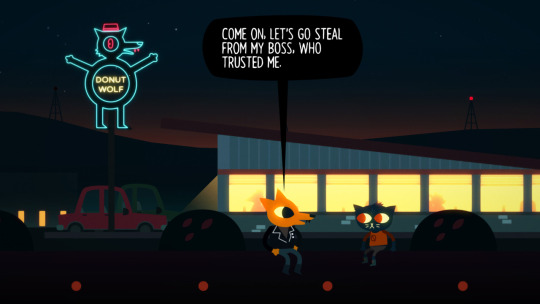
2D games also have quite a special place in my own heart, growing up with Nintendo games and such, so I think that this animation will be quite personal to me whilst I create it, and when it’s finished, it may end up having aspects inspired by Nintendo games, most notably the Mario & Pokémon series.
CHARACTER & BACKSTORY
My character’s name is ‘Ace’. He has no recollection of who named him this, or even if this is his real name, being an orphan for as long as he could remember. Ace has a strong sense of justice, and believes that the world is a terrible place and despises those who perform crimes for their own sake. Whilst in hiding, Ace started training, using a long blade and a regular handgun which he found laying around - perhaps it was once used by a soldier who fought against Puppet. Eventually, Ace came across other like minded people, and soon after, he founded the largest resistance group whose goal was to take down Puppet.
Ace is a male whose age is unknown, although he looks as though he is in his mid to late twenties. He seems to have a somewhat southeastern accent, so he might have been born somewhere in Asia, although he speaks fluent English. he has a very serious nature but this changes somewhat by the end of the story. He usually wears a long white coat with black trousers and black shoes. He has medium-length black hair and his eye colour is grey. Ace’s weapon is a long blade and a regular handgun which he uses when he can’t fight with a blade.
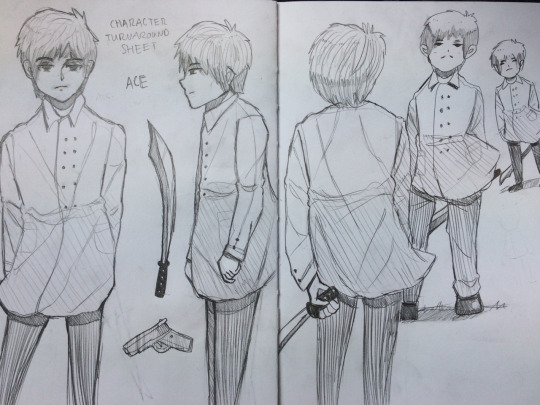
Above is a character turnaround sheet that I drew of Ace, along with some other sketches. I think the first view that I drew (far left) is the best and I was quite pleased with how it turned out, and then I drew the next one which I was significantly less happy with, as I’m bad at drawing side views of people as well as hands, as you can tell, it doesn’t look very proportionate. I think that the next one is a slight step up from the previous one, but it still doesn’t look great, although, I am a little happy with how the hand turned out, holding the blade. The last two are just simple sketches which turned out a little bit too detailed than I had planned. Initially, these sketches were supposed to show off how Ace could look in-game, but as I said, they’re a little too detailed, and I plan on making a fairly simple 2D animation. I’ll work on these at some point. The two other drawings on the left page are just to showcase his two weapons. His long blade, and the regular handgun. The handgun looks a bit disproportionate, but it doesn’t matter since I probably won’t be animating the it, maybe though.
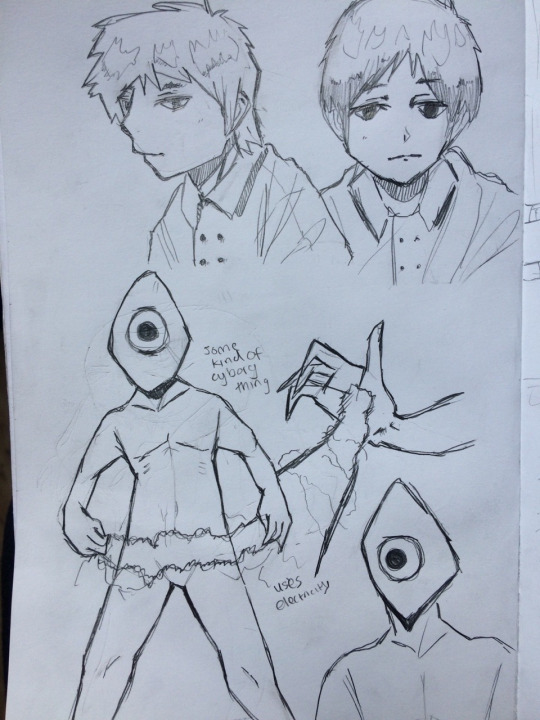
Below are some sketches that I did of Ace and also some of the monster which he will fight. I decided to draw it with one eye, which made it look like a cyclops thing. I decided to keep its design simple, I’ll probably colour it a shade of red or something, since they are just mass-manufactured monsters. When Puppet added offensive capabilities to the monsters, electricity was probably the most easy to produce, so that’s what they gave them. They can materialise electrical energy from their palms, and join them together to amplify its power. Above the monsters are some sketches of Ace. For the monsters, I had to draw a whole body, bar the feet, so this was a little challenge for myself, but I think it turned out decent to some degree - I like the legs especially. I drew the hand with the electricity coming out just to showcase it. They can fire it out of their palms with relatively strong force.

Above is a sketch of a potential background for the animation, however, I draw another one which I think will be bit more suitable. Anyway, my background is set in the future, where neon cyberpunk-esque cities occupy most of the world.
Below is a sketch of a potential background for my animation, I think this will most likely be developed in Photoshop. It’s essentially a row of neon-esque stores with some rooms above where a person will walk by. There’s also a fan or something on the left which will spin - I thought about it and realised that this would be best suited for After Effects, so I’ll try and do that when I’ve finished the main animation. There’s also some hanging lights on the right which I may or may not end up animating in the end. The font on the stores is intentionally eligible. I think this is a solid design in my opinion, so I would like to bring it to life digitally. Below the scene is just a sketch of Ace being showcased with his weapon.

This final page of sketches that I did is just some rough sketches of Ace’s movement at the top, and how he could potentially move about, whilst he slays the monster. I don’t know yet if the animation will contain blood when a monster is slain, but I will most likely decide when I get there. The sketch below it shows the aforementioned scene which I drew, with Ace confronting a bunch of monsters, with a pattern of how his movement could go, like in the sketch above it. I added a reflection of the row of stores to imply that the floor is wet or something. Maybe I’ll add rain somehow, although this seems like a difficult job.
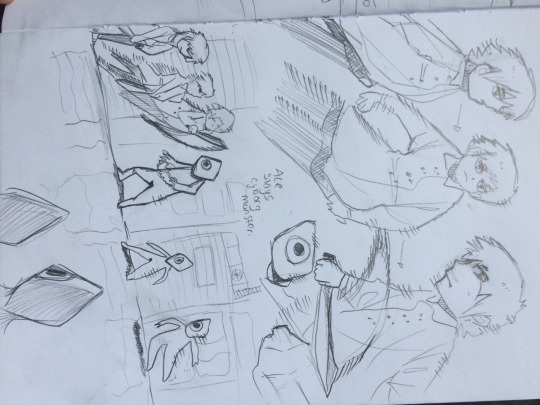
0 notes
Text
“Terminally Ill” – A Message of Hope Dedicated to our brother and strong warrior in Christ – Greg Murtha
"Terminally Ill” – A Message of Hope
Dedicated to our brother and strong warrior in Christ – Greg Murtha
[Update: I originally wrote and posted this lesson in February 2016. Greg went Home to be with our Lord last night. I was with him last week and walked with him out of VUMC as they released him (again). He became ill again very soon and was re-hospitalized. Last night, he awakened in the waiting, loving arms of our precious Savior, Whom Greg loved so much. A mighty soldier of the Cross, who fought, long and hard, and represented Christ so well, now finally Home—at rest and peace. He left behind a powerful legacy—not of who he was, but Whose he is.
In Greg’s honor, I edited the original lesson, where appropriate, and am sending it to you because Greg agreed and wanted all to know that we are “terminally ill”—in desperate need of the Savior he knows so well, and in Whose presence, his spirit now resides.]
This lesson stirred in my spirit for a long time. To be honest, the title scared me. Terminally ill elicits personal, raw emotions for many. I had to be certain I could approach this in a way that communicated truth with big doses of compassion and concern. Greg’s blessing and encouragement to write this lesson provided final confirmation. As Greg put it, these words “need to be received by many, if not all.”
Though I spent most of my adult life in healthcare, I was never directly involved in areas associated with terminal illness. Like many of you, I have walked through it with family and friends. Whether by routine exam or symptomatic changes, the process typically goes something like this.
DIAGNOSIS - Anxiety or Relief. When we receive a good diagnosis, we are glad and relieved. When we receive one we hoped or prayed against, reactions differ. Some seek second opinions. Others are numbed and not sure how to process the information. Still others fall into denial, despondency, or depression. Bad news is hard to take—the truth often hard to accept.
DISEASE. Given the diagnosis we did not want, reality of a sickness that could render us terminally ill sets in as doctors propose a treatment regimen. Again, reactions differ. Some face this process with great courage—eager to fight for their lives. Others are overcome with fear and trepidation, knowing the treatments often have significant side-effects. We may think ahead to the reality of what happens if the treatments do not bring about the cure we seek. That leads us to the third, and final, part…
DEATH. Not many sit around contemplating our passing. Yet it remains the one common denominator of all people. I assume all reading this have attended or been part of a funeral or memorial service. Most of them mourn the loss and try to find something good to say about the deceased. Some celebrate his or her ‘good’ life. But when the service is over, two people remain: the hopeless and the hopeful. We are going to examine the differences.
In the few weeks since you received the January lesson, In the Beginning God, I had the wonderful opportunity to spend precious time with my friend, Greg Murtha, who has very advanced cancer. Our time together was more of a reunion. We lost touch over the last few years. The only news I heard was that he had been diagnosed with an advanced stage of cancer. We met over lunch and caught up on life, families, and, most importantly, his battle with cancer that put him in the dreaded category— terminally ill.
At the time I wrote the original version of this lesson, Greg had endured fifty radiation and chemo treatments. He ultimately had around seventy-five. Throughout, I have never seen anyone handle this kind of adversity with such amazing grace and a demeanor reserved for someone walking closely with our Lord, living in the present of His presence.
God turns bad news into Good News—the hopeless into the hopeful.
Bad News. Death is certain—the contract with a no “escape” clause. Despite your clean bill of health, stellar physical fitness, and positive outlook on life, I have bad news. You are terminally ill. We all are. 100% of all people die at some point. We are going to examine what the Bible says about our death, both of them. I will explain ‘both’ as well. For most readers, these words are not new nor are you reading them for the first time, perhaps just the right time!
Physical Death
Unless the rapture of the Church takes place in our lifetime or God translates us straight to Heaven as He did Enoch and Elijah, we are going to die physically. Jesus died a physical death. Most people do not believe the biblical path to physical death as told in Genesis 3, but they know the story. Christians refer to the sin of Adam and Eve as the fall of man. It could also be called the death of mankind. For reference, here is a link to a video teaching time that discusses this in more detail. (From the Cradle to the Cross)
Genesis 3 teaches us that sin makes everyone terminally ill. We are all guilty of sin, although most people do not like to talk about it or hear they are ‘sinners’. “That sounds so negative.” It is! It’s deadly. The Apostle Paul said it this way,
“Therefore, just as through one man sin entered into the world, and death through sin, and so death spread to all men, because all sinned.” Romans 5:12
You do not have to be a theologian to understand that verse. That is bad news, and it gets worse before we get to the message of Hope people are desperate to hear. Many ask how it can get worse after death. That does not make any sense UNLESS there is something after death more foreboding than death itself. The writer of Hebrews added a phrase to what Paul said that troubles the hearts of men to our core.
“…it is appointed for men to die once and after this comes judgment,” (from Hebrews 9:27)
That phrase and the use of the word judgment absolutely sets off unbelievers from every religion or credo outside biblical Christianity. As Christians, we are more often accused of being “judgmental” than any other verbal assault. The fact that we hold fast to the truths of the Bible and salvation in Christ alone (John 14:6) is offensive to those who walk in darkness, blinded to the Truth. The Apostle Paul pointed that out.
“For the message of the cross is foolishness to those who are perishing” (I Corinthians 1: 18)
[For more detail, you can read about the two judgments in 2 Corinthians 5 and Revelation 20.]
Spiritual Death (from bad to worst)
In the verse from Hebrews, God confirms there is life after death, i.e., physical death is not the end. Many religions teach that. Reincarnation. All good people go to heaven. Our spirits wander around the earth doing whatever. Many religions-many beliefs. One Truth. The Bible teaches sin not only caused physical death, it also brought about spiritual death. Jesus’ ominous words of warning speak directly and clearly.
"Do not fear those who kill the body but are unable to kill the soul; but rather fear Him who is able to destroy both soul and body in hell. (Matthew 10:28)
Jesus went further than teaching there is life after death and judgment. He interjected an even bigger issue for those who disdain Christianity: Hell. Real place, fire, eternal suffering. This is what is meant by spiritual death. Those who experience this death never lose consciousness of their surroundings. It is beyond horrific and unimaginable—the reasons Jesus spoke so much about it. Because He loves us, He warned people of the reality of its existence. Unfortunately, for the lost person, the easiest way around judgment and hell is simply to reject it as false teaching. Call it a lie and today it is. Right?
GOOD NEWS. Finally we get to the good part. Now we will see how Jesus planned to deal with death and give us hope. He did not stop with those foreboding words of Hell and judgment. Jesus said “He came to save sinners.” (Mark 2: 17). Jesus offered a way out – an escape clause from a binding terminal contract.
Jesus’ death for our sins provided complete payment; restitution to Holy God Who demanded the death penalty for our sins. This was the ultimate Gift, offered to all who acknowledge we are terminally ill (sin), repent, and receive His Gift of salvation. Yet most people rejected Him then, and most still do.
Sadly, a gift is only a gift if the one to whom it is offered accepts it. So many terminally ill people walk away because they do not like “the terms of the deal.” They remain determined to find an easier path or continue to call the Truth a lie, unaware they have been deceived by the ultimate liar, Satan. He deceived Eve then Adam. He worked hard to deceive Jesus Himself. Only an arrogant man or fool would believe Satan does not come after us, or we are too smart to be deceived.
HOPE. For Christians, physical death is just the beginning. While physical death is certain, so is life after death. We will experience the same resurrection as Jesus. Spiritual life for Christians is eternal life spent in the presence of God, occupying one of the mansions in Heaven Jesus said He was going to prepare for us—the amazing place John tried to describe in Revelation. Consider the words of Apostle Peter.
“Blessed be the God and Father of our Lord Jesus Christ, who according to His great mercy caused us to be born again to a living hope through the resurrection of Jesus Christ from the dead.” (I Peter 1: 3)
Christians have victory over death. That gives us living hope. Unbelievers search for a hope that better fits their lifestyles; something comfortable and convenient. Death is neither, but it is inevitable. During His life, Jesus offered hope to hopeless captives, the Jews. His offer stands today. He is the only hope for all who are terminally ill, physically and spiritually.
How should we put a wrap on this lesson? I assume we agree 100% of all men die, including us. So let me close by asking three pivotal questions.
1. How much longer do you have to live?
“Moreover, no one knows when their hour will come.” (Ecclesiastes 9: 12)
Solomon wrote this answer that has troubled the hearts of men since Adam was escorted from the Garden. “I don’t know.” We do not know how or when. “Live like there is no tomorrow” is both a secular mantra and biblical mandate. The difference in those lives is HOPE.
2. Have you accepted the Gift that alone can cure your terminal illness?
“Surely He (Jesus) bore our pain and suffering…He was pierced for our transgressions, crushed for our iniquities; the punishment that brought us peace was on Him, and by His wounds we are healed. We have all, like sheep, gone astray…and the LORD laid on Him all of our sins.” (Isaiah 53: 4-6)
A matter of life and death. If you have not settled this once and for all time, I implore you. Please do so right now. We just agreed death is inevitable and the time unknown. God loves you and is waiting.
3. If you have been made alive in Christ, are you living a HOPE-FULL or hopeless life?
“Set apart Christ as Lord in your hearts. Always be prepared to give an answer to everyone who asks you to give the reason for the hope that you have with gentleness and reverence.” (1 Peter 3: 15)
God is faithful in life and death. Then why do so many Christians live as the hopeless? We were made alive forever in Christ. Our living Hope should produce in our lives the fruits of the Spirit, beginning with love for others, especially the lost. People are attracted to the Living Christ in us. Our hope gives them hope. I want to live like that. I hope you do too!
0 notes
Text
Bear.Believe.Hope.Endure: II
“Dear Spencer and Marlene, I just want you to know that I will be praying for you. You can stay tough, Spencer, you keep fighting. I know Jesus will see you through. He gives us perfect peace as we trust Him with all of our heart...I am fighting some of the same battles with leukemia, too. So if you ever need a friend to write to, I will be here for you; especially to pray for you.”
-Your friend in Jesus,
Jenny
I was almost exactly halfway through a 6 mile run, the rain pouring down and my eyes straining to see ahead, when my body started to give up and tell me it had been through enough. Breath became suddenly thick and hard to draw. My joints would strain and erupt in pain with every pounding step. I found myself lost in the overwhelming defeat of realizing that I would be adding 20 miles to this distance come June. I knew that I could finish but I would be settling for the bare minimum and starting down a path of compromise that felt all too familiar and, frankly, frightened me. Then, in a beautiful moment of miraculous clarity, I conjured one word that carried with it the power to dispel any doubt I had in myself and in this whole process: endure. Love endures all things. I remembered the love that brought me to that exact moment of my life. Then, instead of focusing on the future, I called upon the past to remind me why I was running down this path in the cold and rain. I am loved. I love myself and I love the beautiful individuals in my life who need me to not give up when the going gets tough. Beyond the will to keep moving forward, endurance means so much more. Enduring requires a mindful acceptance of the inevitable trials and struggles to come because there is hope in the outcome of being refined. Endurance is not merely a process of hardening my senses and clenching my fists, letting nothing in or out. That will get me to the end but I won’t be changed, just battered and depleted. I think true endurance, driven by love, is opening my hands, exposing my heart, and feeling every single nerve in pain and using the struggle to motivate each step toward growth. It’s being in the moment and staying there when the lies are falling down like rain. It’s holding fast to the truth: I can do this, I will do this, I have to. I’ve spent too many years focusing on the future, worshiping ideals, then forsaking hope when things get hard. I’ve always viewed struggles as a sign of being on the wrong path instead of an assurance that the pathway to peace is laden with opportunities to practice it. Back to reality, I pushed myself to go faster on that day when I was tempted to slow my pace and shut down. 5 minutes later I broke through the wall and finished with a faster time than the week before. All that pain and doubt and fear was necessary to motivate me to achieve a higher level of discipline and physical ability.
And now here I am looking at box full of cards full of prayers full of love full of hope. How can I get through them all? Just one has brought me to my knees in an overwhelming emotion of indescribable intensity. All at once, I was indwelled with so many years of love and support I had never even contemplated before. And then I felt what I had always feared: crippling guilt. I knew this is why I had never opened the door. Just one person, just one card, was so full of selfless encouragement and I never knew. All this time, there was so much power resting in these words unread. I feel it now and I am thankful but it’s so hard not to hate myself for never looking back, for never looking out beyond myself at all the people reaching out. If I had, maybe I wouldn’t have spent so many years wondering if my life meant something. It obviously did to so many people and I’m willing to see that it probably does still now. I can also see that freaking out about getting to the end of this journey, just as I did about reaching the end of that 6 mile run, will only cheapen the value in this process of working through pain. I thought I was going to be able to cover months and months of treatment in this chapter and all of my feelings about it. Instead, I’ve really only processed about 4 days. So buckle up.
Hitting the ground-that’s all I remember. There’s nothing quite as memorable as getting the wind knocked out of you by the solid, immoveable ground after losing grip on the monkey bars. Well, that and the pain the next day. I also remember walking down the hallway in my underwear, my feet on the cold wood floor, out into the dining room where I found my father pouring over something at the table. It was either the Bible or the morning paper, as he has always read both in the morning for as long as I can remember. I complained to him about the pain and I’ll never forget the way he looked at me. He seemed burdened. I was 4, it was early, but I can still feel the presence of a great weight in the air and I’m sure there’s a reason it’s the last thing I remember for months after that.
November 12, 1992. There were a number of reasons my parents took me to the doctor that day, the primary one being chronic stomach pain. In and of itself, this isn’t usually alarming enough to run lab work on a patient’s blood but when combined with whatever else my parents told the doctor that day, it seemed prudent to look for certain underlying issues. This is the first of many instances of curious happenstance: This particular doctor, on this particular day, decided to look past the obvious and read between the lines. Not all doctors do this on all days. That evening, my parents received what they refer to as “the call”. As I look back upon the few details of this day that I know, I can only imagine taking my daughter, who is now the same age as I was during this time, to the doctor because something “just wasn’t right”. As a parent, I’ve had that fear many times. I’ve been overcome by the potential malignant collusion of symptoms into something much more insidious than exhaustion and growing pains. As a cancer survivor there’s a spark of fear in every physical ailment those you love experience, especially your children. And I think I’ve spent a great deal of my life in crippling fear of common ailments because cancer ruined the bliss of ignorance. I know it always could be right there. It most likely isn’t, but cancer also ruins the innocence of chance.
November 13, 1992. The second curious happenstance of note is that my parents were able to find AND get an appointment with a pediatric oncologist in Portland within 24 hours of contact. I’ve gathered that was quite unheard of at the time. From what I understand this doctor, my doctor, took a special interest in me from the beginning and respected the urgency of my situation from day one. Doctors caring seems to be a common occurrence in this unfolding story and that significance is not lost on me. The purpose of seeing her was to confirm the suspicions of our family doctor based on the lab work he had run. The previous day my bloodwork indicated the presence of roughly 3500 blasts, or “bad” white blood cells. I’m still fuzzy on what’s normal but that level was well above alarming. One thing I recently realized is that the “Acute” part of Acute Lymphoblastic Lymphoma doesn’t just mean “bad”. I’ve always thought of “Acute” as intense or pervasive. “Acute” in my case meant rapid and aggressive. The day of this particular visit with the oncologist, my blast count had doubled to 7000. Apparently, this was on a friday and my doctor said to come in first thing monday to start treatment of Leukemia. The third curious happenstance was that my parents wouldn’t settle for that. They had all the reasons in the world to hesitate. My doctor had recommended what she saw as the most immediate and vital approach to the situation. Within 24 hours their worlds had been turned upside down and most people would take a moment, maybe even one day, to wrap their heads around the reality of sudden chronic illness. But, something in them won over all that chaos. Something prevailed over fear that day. My mother insisted that I be admitted as soon as possible, and I can only imagine the fervor which she made such a demand.
November 14,1992. I can only imagine what it must have been like for my parents to have their 4 year old child admitted to the hospital for treatment of Leukemia only 48 hours after discovering its presence in my blood. I remember nothing of this time. I received a blood transfusion. They started doing X-Rays and EKGs of my chest. Im sure it was a whirlwind of confusing chaos and if it was anything like the trauma I’ve experienced in my own adult life, I’d be willing to bet the dominant sensation was numbness. My blast count had again doubled to 14000. I was rapidly entering the “Induction” phase of treatment and I was being prepped to receive chemo the next day. I was about to be thrust into a struggle I had no choice in entering and had no idea what it held in store.
November 15, 1992. This is the day I started Chemotherapy. For the longest time, an embarrassing amount of time actually, I thought Chemotherapy was itself a drug. I thought Chemo was its own thing, just one thing, that killed all the bad things. 21 years later, I now know that Chemotherapy is an approach of using multiple drugs in combination to eradicate every single cancerous blast cell so that it can no further propagate and spread. This is why they resorted to injecting it into my spine and transplanting bone marrow. I’ve also learned that Chemo, to this day, is a really blunt tool and is by no means precise. It’s shocking, actually, to learn that every day is a judgement call as to whether the drugs are doing more harm than good. I came across this amazing article from 1995 by Linda Ellerbee who had gone through breast cancer. Its title? “When all the choices are unpleasant” In it she writes “It’s just so frustrating. Part of me is very angry we know so little about cancer that we must give people such large doses of what is basically poison in order to try to stop this disease. On one level (call it the logic level), it seems to make no sense. However, reality is this: Had I known about the possible heart damage from chemotherapy, I would still have chosen the chemo, and, knowing about the possible harmful effects of tamoxifen, I shall still take tamoxifen. At this time, the chemo and tamoxifen are the best chances I have for continuing to live. These are the choices people with cancer must make. Hard choices, Sometimes we choose wrong. In the end, we all agree: Treating a disease (cancer) by cutting you (surgery), poisoning you (chemotherapy) or burning you (radiation) seems, at best, horribly barbaric. Only good thing is, sometimes it works.” Sometimes it works. By now, you might be wondering why I was keeping track of my blast counts throughout the 4 days of diagnosis and the beginning of treatment. On the day I started Chemo, my counts were at 20000. I’m told children die at 40000. Had my parents waited until Monday to start treatment, it almost certainly would have been too late.
All my life, I’ve been drawn to ask “why?”. I feel like I’ve been given the drive to look for meaning when others don’t for a reason. That’s part of what I’m discovering during this process. To me, the substance that comes to the surface when I dig into the darkness of my past is the unrefined “why?”. Why did my doctor decide to run a blood test instead of blow it off or delay the pursuit of answers as I’ve heard countless stories of doctors doing? Why were my parents able to find a doctor so quick that cared so much? Why decide to insist on expediting treatment? Why was I spared from the brink of death just one day before my blood was irreversibly overcome with cancerous cells? Why did Jenny, my friend in Jesus, “lose” her battle with Leukemia and I “won”?
I don’t have the answers and I’m not ready to find them yet. I do know that that I’ve already been changed in the process of asking and seeking. I do know that I will persist in running into darkness, through the rain, in pursuit of truth. Thank you for sticking with me in all of this. I know it’s messy, but the truth often is, or at least the process of finding it.
0 notes